HEALTHY NUTRITION, HAPPY BRAIN

UNDEREATING MAY BE SABOTAGING CLIENT GOALS


MOOD BOOSTING FOODS
WHAT’S FUELING TEENAGE ATHLETIC PERFORMANCE?
March/April 2023 The O cial Magazine
Food For Thought
As canfitpro embarks on its 30th year, I have frequently been asked: “Mo, having been with canfitpro since the start, what keeps you MO’tivated?” This question has given rise to a lot of ‘food for thought’ as I reflect on canfitpro’s history.
Today, we are seeing greater interest in the role of fitness in supporting better physical and mental health and wellness. More people than ever are embracing fitness as part of a healthy lifestyle. As a result, there is a demand for more qualified and better educated fitness professionals. In 1993, the demand for fitness instructors was at an all-time high with the introduction of Tae Bo, hi-low impact aerobics, step, and Spinning classes. The supply of instructors could not meet demand. One-onone training was taking shape as well, and we started to understand the value of personal trainers. I was fortunate to be in the right place at the right time to be a part of the growth and development that was evolving. I was also blessed to collaborate with an incredible team of leaders who were committed to growing and developing the Canadian fitness industry.
I remember the very first conversation with Patch about establishing a Canadian convention, tradeshow, and related magazine. I asked only one question: Why? His answer has stayed with me for 30 years. Patch said, “We need to help grow the fitness industry by educating more fit pros so more Canadians will have the opportunity to access fitness
in a safe, effective, and fun community/club setting. We will invite our friends in the fitness industry to come and share their knowledge and skills and help owners and operators grow their businesses. We will raise the bar for everyone and inspire more people to join fitness clubs. Don’t worry Mo, a person named Darin Dieterich will contact you and show you the way.” Darin did call me, our friends in the industry did come and many of them continue to present at canfitpro events to this day. Within two and half years of our first event, we moved our conference from London to Toronto, and I guess you can say ‘the rest is history’.
I share this part of our history to bring attention to the importance and value the fitness community has on every fitness professional’s career. We are learning, growing, and developing our careers together and I am grateful we have access to the latest and best education in the world right here at canfitpro. Every issue of canfitpro Magazine is rich in content as our authors and contributors share their wealth of knowledge, and lessons, from their firsthand experiences. As a member of canfitpro, I am grateful for this resource and to these experts and I hope you feel the same. The knowledge in this issue will more than fill your cup so drink up, learn, enjoy, and continue to excel.
March/April 2023
Chief Operating Officer
Maureen Hagan mohagan@canfitpro.com
Director of Operations
Michael O’Neil moneil@canfitpro.com
Director of Business Growth
Robert Robinson rrobinson@canfitpro.com
Managing Editor Erin Andersen eandersen@canfitpro.com
Graphic Designer
Imran Mahmood, imahmood@canfitpro.com
Marketing & Communications Manager Manhail Sami, msami@canfitpro.com
Events Experience Manager Jennifer Pitt, jpitt@canfitpro.com
Senior Account Manager, B2B Sales Bill Loker, bloker@canfitpro.com
Member Experience Manager Fatima Sunga, fsunga@canfitpro.com
Fitness Advisory Panel
Terence Boateng
Nathalie Lacombe
Melanie Levenberg

Jessica Maurer
Erin Phelan
Trevor Pickett
Funk Roberts
Jess Silver
Ben Siong
Dwayne Smith
To Subscribe
canfitpro Magazine is published six times per year by Canadian Fitness Professionals Inc. New Professional Memberships with canfitpro are $120 per year (plus GST/HST) and renewals are $98 per year (plus GST/ HST) and include a subscription to the magazine. For more information, please contact Member Services at ext. 301.
Feedback or to contribute to canfitpro Magazine please contact: canfitpro Magazine 110-225 Select Ave. Toronto, ON M1X 0B5 416-493-3515 Toll Free 1-800-667-5622 Fax (416) 493-1756 magazine@canfitpro.com
Contact info@canfitpro.com for questions regarding membership, conferences, and Canadian fitness resources.
Maureen “Mo” Hagan Chief Operating Officer
canfitpro is a division of Canadian Fitness Professionals Inc. Canada Post Canadian Publications Mail Sales Product Agreement No. 40783518 - Return Postage Guaranteed
canfitpro March/April 2023 2
from the COO
Note
Photo Credit: Angiesphototeam
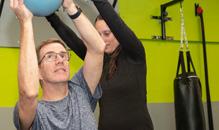



3 canfitpro March/April 2023 CONTENTS 50 48 42 GROUP FITNESS 50
BACK TOGETHER: PARKINSON’S GROUP FITNESS Key take aways to program an effective Parkinson’s fitness program CHILDREN’S FITNESS 52 SETTING THE STANDARD FOR CHILDREN’S FITNESS Qualified coaches build lifelong fitness enthusiasts HEALTHY LIVING 54
DARK SIDE OF THE HEALTH INDUSTRY Recognizing when health choices become allconsuming DIVERSITY, EQUITY & INCLUSION 32 The Gear to Health and Vitality: Movement Developing the social consciousness of fitness as universally important NUTRITION 34 Undereating May Be Sabotaging Client Goals Protecting our metabolism for body composition changes 40 What’s Really Fueling Teenage Athletic Performance? The dangers of supplements and effects of misuse 42 Mood Boosting Foods Plant-based nutrients to improve mental wellness EXCERPT 46 FLUID AND SODIUM NEEDS DURING EXERCISE This Is An Excerpt From High Performance Nutrition For Masters Athletes, By Lauren Antonucci TRAINING 48 Core OFF the Floor Functional exercises to stabilize an upright dynamic posture FITNESS BUSINESS JOURNAL 18 3 BENEFITS TO INVESTING IN ACTIVE RECOVERY SERVICES 20 5 QUESTIONS FOR BUSINESS GROWTH 24 THE SOCIAL ASPECT OF FITNESS 28 LEVEL UP YOUR CUSTOMER RETENTION STRATEGIES IS ELIGIBLE FOR 1 CEC VOUS DONNE ACC can tprointeractive.com 1 CEC REGULARS 2 NOTE FROM COO 6 THE WARM-UP 8 PRO TRAINER SHOWCASE 12 MEMBER SPOTLIGHT 14 PRO-FILE COVER STORY 36 HEALTHY NUTRITION, HAPPY BRAIN The role of nutrition on brain health 38 Alimentation saine, cerveau heureux ! Le rôle de l’alimentation dans la santé cérébrale IS ELIGIBLE FOR TO TAKE THE QUIZ LOG INTO canfitprointeractive.com 1 CEC can tprointeractive.com 1 CEC 54
FIGHTING
THE
• General and professional liability, including abuse
• Working with children
• Fitness equipment protection
• Fitness facility protection
• In-home studio protection
• CPR training coverage
We’ve added coverage for “on-line training” for fitness trainers, which given the COVID-19 circumstance is more important than ever. To deal with current challenges, we temporarily eliminated the requirement for 50% of training revenue from “on-line training” so that fitness instructors could continue to work while face-toface appointments were not possible and fitness facilities were closed.*
Building Confidence. Together.
For more than 90 years, we’ve been a trusted insurance, risk management and consulting partner for businesses, communities and people around the globe. Customizing programs and solutions tailored to your needs. Driving better outcomes for your people and your organization. Helping you build the confidence to handle whatever comes next.
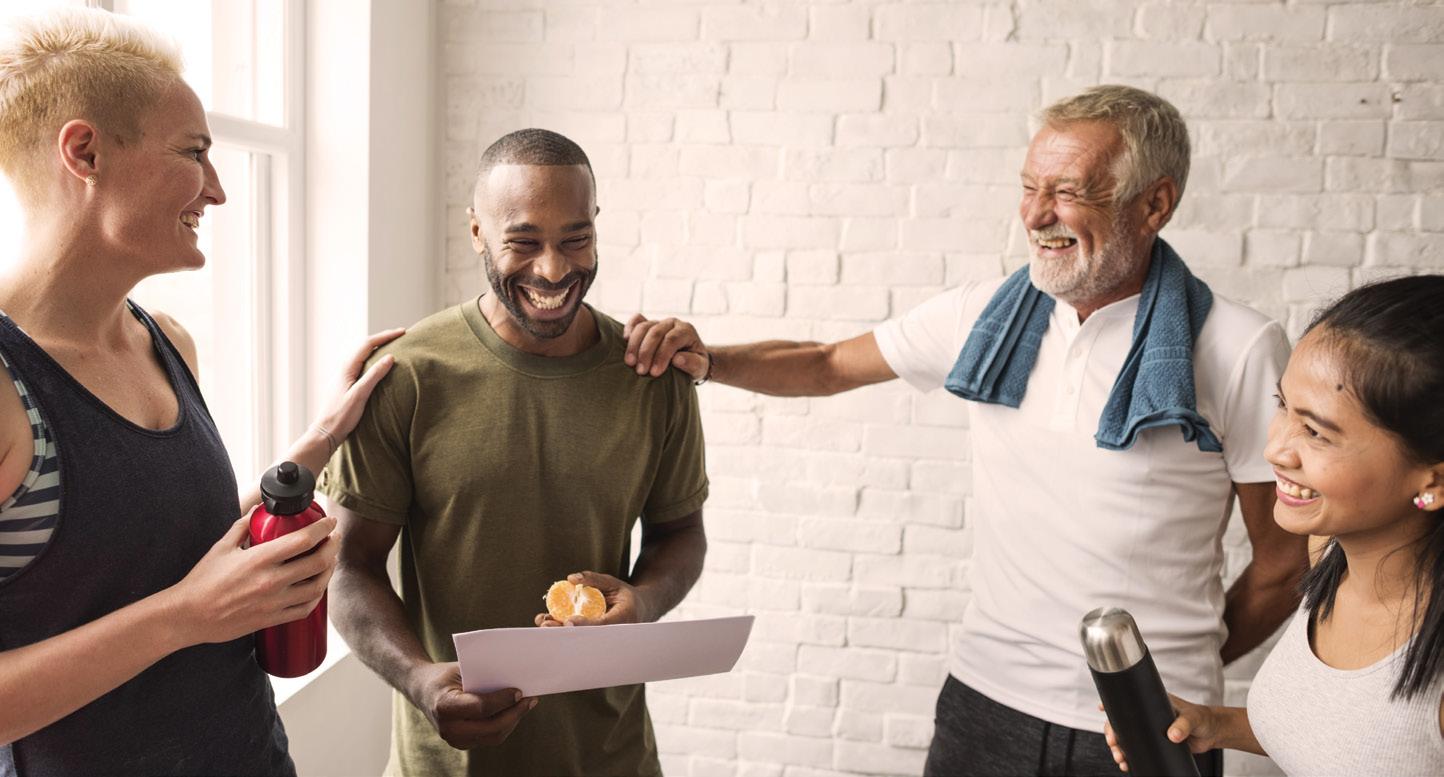
*This condition will be reinstated once the COVID-19 situation has dissipated.
ANNUAL PREMIUM STARTING AS LOW AS $158.00


AJG.com/ca | The Gallagher Way. Since 1927. Apply online or learn more by visiting: ajg.com/ca/canfitpro
canfitpro is proud of our staff and their commitment to helping you, our valued members, be successful. Our staff come from diverse and varied backgrounds and bring a wealth of knowledge, expertise and experience to their roles.
What is one interesting fact you can share about yourself?
I have lived in different countries, different cities, and I know five languages including English, Hindi, German, Urdu, and Punjabi.
How long have you been working at canfitpro?
I started in October 2022.
What is your role and what do you do for canfitpro?


I am the Email Marketing Specialist. I strategize campaigns, work on the customer journey, ensure communications are interactive, and track all metrics related to outreach.
family’s, daily routine.
Which canfitpro core value most resonates with you?
Caring Community: the diversity and teamwork, the inclusivity, and the will to grow together.

What is your favourite form of exercise or physical activity?
I walk a lot and go to the gym at least four times a week.
How do you incorporate fitness into your life?

I take health breaks during the day and schedule a walk during the evenings. I try not to be too fixated, rather I just try to keep it fun.
Name Akanksha Dhingra


Nick Name:
Ashi
Country of birth:
New Delhi, India. I moved to Canada when I was young. I call Canada and India both my home countries.
Why is what you do with canfitpro important to you? canfitpro is important to me as it lets me grow, evolve, and learn new things in not just marketing but inclusivity, teamwork, team growth, fitness, and more. My role at canfitpro is one of my first after my graduation from Toronto Metropolitan University. I am grateful for it being a wonderful experience. I have met talented people who are always here to help.
Do you hold a canfitpro certification? No, but it is on my list for 2023!
What is your Super-Power? My languages, diversity, different perspectives, and communication.
What do you want to be remembered for? A person who is kind and would always be happy to help. I absolutely love making
THE WARM-UP FITNESS COACH CHILDREN’S Learn more at canfitpro.com/ childrens-fitness-coach INSPIRE A GENERATION TO BE ACTIVE FOR LIFE!



7 canfitpro March/April 2023 canfitpro.com/cpr-aed CPR & AED SAVE TIME. SAVE LIVES. A certification that impacts lives in seconds CPR – A (Adult CPR) $43 CPR – A & AED (Adult CPR & AED) $65 CPR – C (Adult, Child & Infant CPR) $60 CPR – C & AED (Adult, Child & Infant CPR & AED) $69
by FIND A COURSE NEAR YOU!
Powered
canfitpro PRO TRAINERS
Meet the team ready to certify you!
Blenda Chan
Toronto, ON
Courses Taught: PTS
How do you use your nutrition knowledge and experience to inspire students in your courses?
Beyond being a canfitpro PRO TRAINER, I am a Registered Holistic Nutritionist™. My passion is to teach others the importance of good nutrition and healthy lifestyle habits. As a teacher and mentor, I always encourage students to dig a little deeper when it comes to learning about nutrition. Nutrition facts are everywhere, different sources will say different things. So, it is important to get your facts and resources from reliable sources.
I am always going back to class, getting new certifications, and always upgrading my skills. I encourage all students to keep up with their education. Adding additional courses and certifications can help individuals new to the fitness industry gain more knowledge in the field of nutrition. canfitpro offers Healthy Eating & Weight Loss Coach certification online with a live instructor or in-person.
How can having more education around nutrition benefit a personal trainer when working with their clients?


Knowledge is power. Having knowledge and understanding the basics in nutrition plays a key role in understanding how we
@blendachan
eat today. With the mass production and marketing of unhealthy foods, processed and packaged junk food is even more enticing and irresistible. All these nonfoods have altered our taste buds, and
canfitpro March/April 2023 8 PRO TRAINER SHOWCASE
our desire to eat unhealthy foods raises our dopamine levels causing us to want it even more. Thus, making it difficult for us to go back to eating real-foods, wholenutrient dense foods that are in the most natural state.
Having education in nutrition can help you provide the best nutritional guidance to your clients for them to achieve the goals they desire. Clients often see a personal trainer with a goal in mind. By strategically collaborating alongside with your client and providing nutritional guidance will get them results even faster.
Why do nutritional habits have a direct effect on your workout routine and goals?
Not all sugars are equal. Eating a bowl of fruit loops will not have the same nutrients as a bowl of oatmeal. Eating two stalks of celery will give you more fiber and nutrients than drinking a glass of celery juice. You will be surprised to know how many people believe they can just simply count calories but not
Rob Dickson Charlottetown, PEI Courses Taught: PTS, HWL, CPR, FMA

How do you use your nutrition knowledge and experience to inspire students in your courses?
I often use real life case studies or stories from past personal clients. These case studies are great at highlighting how impactful a little nutrition knowledge can be. Sometimes we forget that everyone does not eat like we do or have the same nutrition knowledge we do. Showing students food intake journals from real clients can be an eye-opening experience. I speak to the small changes that were made to the client’s nutrition habits, which help to demonstrate with a little knowledge you can transform someone’s life. We explore the outcomes as well as the ups and down, the positives and negatives those clients had on their nutrition journey. Students find this very helpful in preparing them for actual clients.
How can having more education around nutrition benefit a personal trainer when working with their clients?
From my experience, almost all clients will ask at least one nutrition related question at some time during their personal training sessions. It may not be addressed initially, but eventually a
worry about the type of food they are eating. Building healthy nutritional habits is particularly important instead of going on fad, unrealistic diets that are difficult to maintain, and often cause more harm than good. Poor food choices will often increase the risk for health problems such as cardiovascular diseases, diabetes, stroke, and cancers.
You hear this often, and it is true, “you can’t out train a bad diet.” Fitness and nutrition go hand in hand. Healthy nutritional habits such as drinking a minimum of three to six liters of water daily and eating a variety of fruits and vegetables will directly impact our bodies’ processes. Without suitable nutrition, our body becomes weak and malnourished, and unable to perform properly. Implementing sensible nutritional habits will have a direct effect on your workout routine and goals. It takes time to build healthy habits that are sustainable. When we really focus on eating delicious whole foods, we feel better and perform better.
What is your favorite food?
I absolutely love apples. This brings me back to a time when my parents took me apple picking as a child. I still remember sitting on my father’s shoulders to pick apples from the top of the tree. Apples are a reliable source of vitamins and minerals, loaded with fiber and antioxidants. An apple a day keeps the doctor away!
“Exercise is king, nutrition is queen, put them together and you’ve got a kingdom.”
- Jack Lalanne
nutrition related question does present itself. Your client views you as an expert in the fitness industry. With nutrition education, you can help your clients navigate the overwhelming amount of nutrition information available from various sources. Having that knowledge is beneficial in providing more value in your personal training sessions, it can easily set you apart from those trainers that do not possess that knowledge. You can also create another revenue stream by providing separate nutrition coaching sessions.
Why do nutritional habits have a direct effect on your workout routine and goals?
As the old saying goes, you are what you eat. The food that you consume influences many aspects of our lives, from energy levels, inflammation, recovery, diseases, focus, mood, and much more. Not having enough energy can mean a less than optimal workout. Too much energy and your body will store it to be used for later. Not enough of certain nutrients can impact how you recover from your workouts. Daily, you need the correct amount of energy to fuel your workout and the rest of your day, but not too much. And you need to balance that with the correct nutrients to aid in recovery so you can fully engage in your next training session.
What is your favorite food?
Cheeseburgers! I have loved them since I was a kid, my favorite comfort food. If I am going out somewhere to eat, most of the time I will try the cheeseburger that is on the menu. You do not have to deprive yourself of your favorite food, even cheeseburgers can fit into your nutrition plan.
9 canfitpro March/April 2023
@t3fitnesspei
Simran Chohan Brampton, ON Courses Taught: PTS


How do you use your nutrition knowledge and experience to inspire students in your courses?
There is a lot to learn when we begin to discuss the impact of nutrition and fitness, and this can become overwhelming for our students. I am excited to share the nutrition knowledge and experiences I have gained with future students that will be taking my course. As a coach, it is important to connect what we learn within the course material to real life situations. Nutrition is more than giving our clients a “cookie-cutter diet”, it is about understanding what is most important to each unique client. My goal as a coach is to help people change and to promote connections that we can make within the nutrition and fitness industry.
How can having more education around nutrition benefit a personal trainer when working with their clients?
As both a PRO TRAINER and an exercise nutrition coach, I am a big believer that nutrition is equally as important as exercising and keeping up with a consistent workout routine. Having an education in nutrition is not only about providing guidance for your clients, but also about discovering the root of the “problem” that they are facing and providing accountability, whenever they need it. This has benefited me while training clients as it allows us, as the
Elisa Choi
Calgary, AB
Courses Taught: FIS, HWL
How do you use your nutrition knowledge and experience to inspire students in your courses?
My nutrition knowledge and experience can motivate, and educate clients to create a healthy, sustainable relationship with food. Knowing when, how and what to eat to achieve their health and fitness goals is important. I will share testimonials and success stories from past and current clients, along with my firsthand experiences and journey.
How can having more education around nutrition benefit a personal trainer when working with their clients?
Nutrition can complement your workout plan and help achieve your health and
coach, to uncover what factors may be affecting the client’s training routine. When they are not training with you at the gym, are they eating a nutritious meal before and after training? How does your client feel after eating their meals throughout the day? Satiated and full or hungry and tired?
It is easy to get lost in the fad and yoyo diets that surround us through social media, the news, and even within the community. As a nutrition coach, having that further education will ensure that your client is receiving the most up to date and evidence-based knowledge while working towards their goals.
Why do nutritional habits have a direct effect on your workout routine and goals?
When I joined the Rugby team in my last year of high school, I never understood why “eating healthy” was so important. I would eat fast food and train simultaneously and still see results; it was something that worked for me. Until it did not. When I began living on my own, I started to focus on nutrition and incorporating it into my existing workout routine. I never realized how much energy food could provide me with. There are a lot of factors that contribute towards this, such as eating whole foods, supplementing with caution, and avoiding trigger foods, etc. All these factors influence our mood and how our body interacts and responds to those foods.
Building nutritional habits such as meal
fitness goals. A personal trainer with an education in nutrition benefits their clients with sound nutritional guidance on how to properly fuel their bodies before and after their workouts. Most Personal Trainers see their clients at least once or twice a week, therefore in a great position to encourage and motivate their clients to make better food choices to provide their bodies with the nourishment they needs.
Why do nutritional habits have a direct effect on your workout routine and goals?
Nutrition and physical activity go hand in hand to improving athletic performance, to maximize your workout routine and overall health. What you eat on a regular basis, before and after your workout, can make a significant difference in how you feel and perform during your physical activity. It is imperative to fuel your body with good nutrition. Without the proper
prepping, tracking macros, and smaller actions such as planning grocery lists for the week and putting away distractions during mealtimes has helped me progress towards my long-term goals. Creating and building on my existing nutritional habits through short-term goals has helped me a lot with intuitive eating and having a balanced lifestyle while also staying consistent with my workout routine. Ensuring that at least four to five of the meals and snacks I have throughout the day are nutritious (and tasty of course), gives me confidence that I am on the right track.
What is your favorite food?
This is a hard choice when you are a bigtime foodie like me but, my favourite food would have to be donuts!
@emc2fitniti
macro and micronutrients, you can feel sluggish, and fatigued to partake in any physical activity.
What is your favorite food?
canfitpro March/April 2023 10
I love Korean food! Especially Bi Bim Bap because it is delicious, versatile, and nutritious. My favorite way of eating it is in a hot sizzling stone bowl, which is called Dolsot Bi Bim Bap. @fitwithsimm

YOUR BODY IS NOT YOUR RESUME
Meet Jessie Thomas, finalist for canfitpro Fitness Instructor Specialist of the Year 2022
Please describe what you do in the fitness industry.
I have been in the fitness industry since 2007 as an instructor and coach. Currently, I am the owner and founder of Farm Girl Fitness - a small group training studio located on my family’s farm in Halton Hills, Ontario. We are a fitness facility that opened in June 2020 that

focuses on providing a safe, fun, and comfortable space for people to move their bodies, indoors and outdoors.
I manage the day-to-day operations of the business, which includes sales, marketing, program design, customer service, and more. I also teach four to five classes a week and train one-on-one clients as well.
What challenges have you overcome and what did you learn that has made you a better fitness professional?
The two biggest challenges I have overcome in my time in the fitness industry are: the COVID-19 pandemic and my physical injuries.
The pandemic was a two-part challenge
canfitpro March/April 2023 12 MEMBER SPOTLIGHT
because 1) it is why I lost my job that I had in the industry for 13 years, but 2) it is also the reason I started my own business.
When you start a fitness business during a pandemic, you should know what kind of challenges might come your way but, to be honest, there were many that surprised me. The hardest part was when the province shut down outdoor fitness in 2021. I remember being in tears when hearing that announcement and feeling hopeless. I had seen how being outdoors was helping so many people, physically and mentally, get through this unprecedented time, and then when the rules changed again, I felt like I was letting people down and it was out of my control. The biggest lesson of that time was to constantly focus on what you can control and believe that things will get better.
My other challenge over the years has been my physical injuries. In 2009, I suffered my first of many disc herniations, which made it impossible to walk some days, let alone teach fitness classes. This past year, I have also dealt with very high blood pressure and uterine fibroids
which has led to excessive bleeding and exhaustion. All these physical challenges have made it exceedingly difficult to perform the job I love at times, leaving me feeling worthless and frustrated. However, the challenge has also helped me be more compassionate and understanding of those with chronic illnesses. And my teaching style is definitely different now than when I first started teaching in my mid-twenties.
What do you believe sets certain fitness professionals apart from the rest? Humility. The day you think you are the best instructor or coach around you are dead in the water. Being a good teacher means you need to be a great student. Accept feedback and ask for it when it is not given. The fit pros that stay humble will learn the fastest and help others to do the same.
What piece of advice would you give your younger self?

Your body is not your resume. Stop thinking that people are judging your ability to coach or teach based on your weight or shape. Even if people are

judging you for this, those are not your people.
For so long, I doubted my abilities because I did not look like anyone in the fitness videos that I watched. I held myself back and played small because I thought I had to look a certain way before I could reach out for greater opportunities. I hope that this future generation of fit pros can see a wider range of body types in the industry and know that there is a place for all.
What keeps you motivated?
My clients and members. They inspire and motivate me every day. I get a front row seat to their fitness journeys. I get to hear about what they are going through and see them conquer their biggest obstacles. They remind me what this profession is truly all about; helping people see that they are stronger than they know.
Penny Oleksiak


farmgirlfitness.ca/ info@farmgirlfitness.ca
IG: @farmgirlfitness.ca
FB: Farm Girl Fitness
Penny knows the role magnesium plays in muscle relaxation and recovery. Bolton’s Naturals’ line of topical magnesium products provide an easy and e�ective way to get magnesium directly to muscles. Plus, it helps with better sleep and stress relief!







boltonsnaturals.com















13 canfitpro March/April 2023
• P ROFITS A R E D O DETAN OT H E PL DNE W O R L D POVERTY
Bolton’s Naturals gives 100% of profits to thriveforgood.org to help fight global poverty
“train, magnesium, recover, repeat”
JAN - CANFITPRO.indd 1 2022-11-11 9:01:55 AM
(World champion swimmer and Canada’s most decorated Olympian)
DELEGATES’ CHOICE SPECIALTY PRESENTER AWARD 2022: SARA HODSON
What is it that you do within the fitness industry and how long you have been active in this role?
I am the CEO of LIVE WELL Exercise Clinic, a medical fitness franchise business
I began in 2011 when I saw a huge gap in the market. I began my career as a Clinical Exercise Physiologist in a cardiac rehabilitation program in a hospital in White Rock, BC. We would have patients who finished our program and had nowhere to go to continue exercising safely and with supervision. What began as one clinic has expanded into clinics across three provinces, helping thousands of Canadians stay motivated and embrace health and wellness - often in their later years!
When the pandemic began, I knew I had to get involved helping our industry. I reached out to the Fitness Industry Council of Canada (FIC) to volunteer my time. This quickly snowballed and I became not only co-chair of the BC coalition, but one of the driving forces behind FIC’s lobbying efforts for physical activity tax credits, as well as our continuing efforts to revise line 33099 of our income tax forms to make gym memberships eligible as a medical expense.
In August 2021, I was elected as President of the FIC. I believe that one of the reasons was my unwavering commitment on the essential role exercise plays in our physical, mental, and social health, and the power we have to positively impact the lives of
Canadians, reduce rates of chronic illness, and improve mental health. I am also an active board member of Prescription to Get Active and am routinely asked to speak on the role exercise plays in healthcare.
What is the biggest mistake you have made and how have you learned from it?
The biggest mistake I have made is not setting boundaries, and not putting my own mental and physical health as a priority.
I can relate to so many of my LIVE WELL clients, and to all Canadians who struggle with finding time to be physically active. During the height of the pandemic, when I was pivoting my business to virtual, supporting my franchise owners, working double-time with the FIC and continuously being interviewed by the media, preparing decks and slides for meetings with government - well, my own exercise habit was put on the back burner. I am a mom to four teenagers, and so you can imagine that work-life balance is tricky.
In the last three years, I have learned that if I do not take care of my physical and mental health, everything else falls apart. I have learned to ask for help when I need it, and to unplug and recharge as often as I can.
How have you changed as a fitness professional over the years?
I am always learning - not only as a fitness professional, but as a business owner and now as President of FIC. We learn from
each other, and I have been extremely fortunate and privileged to get to know some exceptional people over the years. I have learned that fitness businesses used to be in competition, but now we are all going after the same goal - making Canada a healthier and more vibrant country, and helping as many Canadians as we can. This is why we need to have physical activity tax credits and to make gyms accessible to all.
What advice can you share with other fitness professionals to be successful? The biggest piece of advice I can give is to follow your passion and to create a niche for yourself and business - whether you are a personal trainer, group fitness instructor or you decide to open a fitness franchise! We have a huge demand for our expertise. Do not be discouraged by any setbacks. Every setback I have ever experienced has been a steppingstone to something even better than I ever imagined. The work we do is challenging, but so rewarding. We are saving lives!
What does this award represent to you?
I am touched and honoured to be recognized by an industry I am so proud to be a part of!
livewellclinic.ca
sara@livewellclinic.ca
IG: @sara.with.a.spark
LinkedIn: Sara Hodson

canfitpro March/April 2023 14 PRO-FILE
Photo Credit: Dawn Bowman


Register Now at canfitpro.com/continuing-education CEC online courses and quizzes Upgrade your knowledge and maintain your certification.

18 3 BENEFITS TO INVESTING IN ACTIVE RECOVERY SERVICES 20 5 QUESTIONS FOR BUSINESS GROWTH 24 THE SOCIAL ASPECT OF FITNESS 28 LEVEL UP YOUR CUSTOMER RETENTION STRATEGIES
3 Benefits to Investing in Active Recovery Services

PRIORITIZING YOUR MEMBERS’ OVERALL WELL-BEING PRESENTS A UNIQUE GROWTH OPPORTUNITY
By Chris Smith
canfitpro March/April 2023 18 JOURNAL
As integrative and holistic approaches to fitness, health, and wellness continue to emerge, we are seeing a focus within the industry on active recovery, as demonstrated in the canfitpro Fitness Trends Report. This report highlights the top trends and opportunities that are predicted to have the greatest influence throughout 2023.
Coming in at number five, active recovery serves both mental and physical wellness and, to put it plainly, is when you do some form of movement that is less intense than your average workout. Incorporating low to moderate intensity movement on rest days helps the body recover by increasing blood flow to muscles and tissues, reducing stress and anxiety, and promoting relaxation. Recovery-focused classes in between workouts and accessible recovery tools boost circulation, giving muscles what they need to repair after a tough workout.
For clients, the goal of active recovery is to help their body return to homeostasis so that in between tough workouts bodies feel refreshed, no longer sore, and ready for their next session/class at the gym. For club owners and organizations, the trend offers a unique opportunity to support members in more areas of their fitness journey with expanded in-club services and, overall, more touch points to connect with members.
With over 27 years of experience in the fitness industry, and as president and CEO of Fitness World, I have seen the tremendous impact education plays in empowering people in their fitness journey, which is why innovation at our clubs is built around educating members on the importance of a pre- and post-workout routine. This prioritizes members’ overall well-being, promotes healthy muscle recovery, and helps to prevent injuries.
Internally, our number one goal has always been to provide the facilities, support, and services to help our members achieve their fitness goals, and rest and recovery plays a significant role in this journey for everyone. In addition to offering in-club and online active recovery classes such as Recover+Reboot, Body in Balance, Pilates, and Yoga, which all provide a dynamic fusion of functional movements and stretches that help to realign, rest, and re-energize, we have scaled our recovery-focused amenities significantly over the last couple of years. Incorporating a dedicated recovery zone into every Fitness World facility and providing members with the latest in recovery technology such as HydroMassage, Normatec Legs, and Hyperice, we are not only promoting recovery on rest days, but we are creating a supportive and engaging environment where members want to be.
The trend in active recovery is a huge growth opportunity for owners and businesses to invest in services that promote relaxation and muscle recovery while supporting members’ overall physical and mental wellness.
Three benefits of incorporating active recovery services:
1. Supports overall member retention. Recovery services and amenities helps engage new and current members for longer. Members who participate in active recovery are less at risk of injury and therefore, less likely to cancel or freeze their membership. These services are also setting members up for success in reaching their fitness goals and, as we know, members who see positive results and reach their goals are more likely to maintain their membership.
2. Increases membership engagement by investing in and providing recovery services that offer opportunities to serve members before and after their workouts. It turns your gym into a 24-hour service provider, and not just a one-hour per day experience.
3. Creates additional revenue opportunities. Enhancing member experiences with new amenities and services offers an opportunity to restructure pricing models – whether it is an overall bump on current membership levels or an add-on approach, recovery tools can bring in an additional source of revenue.

Chris Smith is the president and CEO of Fitness World, leading the operation of 16 clubs across British Columbia, Canada. He is also the founder of British Columbia Personal Training Institute (BCPTI), serves on the Board of Directors for IHRSA (International Health & Racquet Sports Association), and has recently founded ATFW, a digital media company focusing on All Things Fitness & Wellness.

19 canfitpro March/April 2023
5 QUESTIONS FOR BUSINESS GROWTH
USE THESE AREAS TO DETERMINE YOUR GROWTH IN THE NEXT 12 MONTHS
By Sean Greeley
How far and how fast can your fitness business grow in the next year?

To get the answer, you need to assess your business and discover:
• Your fitness business’s unique strengths.
• Where you need to improve.
• What you will implement to overcome any deficits.
In the past 12 months, we have worked with hundreds of fitness professionals and business owners. And we have seen five areas that each fit pro and entrepreneur needs to examine to grow their business throughout the next 12 months.
Look at these areas to see where you need to improve your form.
1. How optimized is your business for profitability?
Most fitness businesses struggle to break even every month – even though they could be achieving 30 percent profitability or more. To maximize your fitness business success, look at six “profit keys’ to determine how well your business is performing:
• Revenues--what (and who) drives your revenue growth?
• Cost of revenue--how much do you spend fulfilling your services (usually paying a coach)?
• Gross profit--revenue minus cost of revenue is gross profit. You should be above 65 percent; ideally, it should be above 80 percent.
• Expenses--You need a good lease, but ensure your other expenses are working hard for you. Expenses are
investments that propel your business.
• Operating Profit--Revenue-Cost of Revenue-Expenses = Operating Profit. It should be 20-30 percent. If it is not, you need to re-engineer the money math so it is.
• Net profit--Hire a good accountant and tax advisor to keep more of what you make.
2. How strong is your team?
Your team will either drive powerful growth throughout the next year or be a source of ongoing pain.
The key to success is to have a strategy for dialing in your team design, your team avatar, and your hiring and development processes. You need to know who you want to attract, and how to attract them. And once you hire them, what to do to develop them and have a career path
canfitpro March/April 2023 20
JOURNAL
so they stay.
3. How effective is your sales process?
You do not want to waste time with unqualified prospects. And you do not want to lose good leads because your sales process is not dialed in.
We teach a 7-step sales process that is customized for the fitness industry and will help you close 80 percent or more of your consults.
Here are some keys to dial in your sales process:

• Only meet with people who can afford your prices, can decide, and will decide -- use a prequalification call before you set up an in-depth consultation.
• Build rapport and uncover needs … identify the problem and what it is
costing the prospect -- as well as why they cannot solve the problem on their own.
• Offer the solution through a visual presentation and offer a choice of packages when you ask for the sale (e.g., Would you like to sign up for the three-month or the six-month program?)
4. Are you leveraging social media to generate leads and build your awareness online?
Use social media to create a powerful lead generation pipeline. You do not need to be a star on social media. Just use effective strategies to find YOUR ideal clients and attract them.
What you will need is:
• A professional, organized, and useful social media profile. This means you have a picture on Instagram and Facebook where you are welcoming and professional. You need to clearly state your value proposition, an offer, and your contact information.
• Content that is focused on solving your ideal client’s problems and building your credibility -- in other words, why you are the people who can solve it.
• Strong offers that will encourage your ideal client to keep engaging with your content. That way, you can start a dialogue with them with the goal of leading them to solve their problems by becoming a client.
5. Can people find you online when they are ready to buy?
Right now, there are hundreds (if not thousands) of people in your local market searching for studios and gyms just like yours every single day. And they are ready to buy. Eightyfive percent will contact the business within 24 hours of the search.
And 90 percent of these “hottest leads” go to the top three search results. This is called the Google “Map Pack”.
How are you showing up online when people search for things like: best gym, fitness studio, personal trainer, etc., near me? Are you showing up at all?
Is the information you offer online
accurate? There is a lot to improving your results, and success has to do with the consistency and credibility of your information across the entire Internet.
To get started, focus on a strong Google My Business page and make sure your online reviews in Google, Yelp, and Nextdoor are four stars or above. (Ask clients to give you reviews if you need to improve and answer every negative review.)
If you want to see how you show up, you can scan your business for free using this free tool
Summary
Once you have assessed where you are, you are ready to address your key issues.
Get the money math right, get a plan for your team, dial in your sales, lead local search processes. With all those in place, you are ready to grow throughout the next year.
Need more info? Want to predictably grow your profitability to 30 percent while increasing revenues and building a strong team? Get immediate access to the NPE FITNESS BUSINESS GROWTH MACHINE™ to get five proven playbooks with short, 15-20 minute training videos that give you the exact strategies you need to create a highly profitable and predictable studio/gym business.
NPE delivers the #1 suite of business growth systems, tools, and coaching for fitness entrepreneurs to grow to 6-, 7-, and 8-figures. Since 2006, NPE has helped over 53,000+ fitness businesses in 96+ countries grow to the next level. NPE has been featured 8x on the Inc 500/5000 list of fastest growing companies, and has a global team based in the USA, Canada, UK, and Australia.

21 canfitpro March/April 2023
Sean Greeley, NPE Founder and CEO, has an unrelenting passion for empowering fitness entrepreneurs to create the income and lifestyle they want.
Turn Your Passion Into a Fitness Business Earning
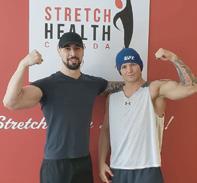

$10K/Month - Online, Offline and Hybrid
In this training you will discover:
A proven framework to gain instant clarity on who you want to work with, the problems you enjoy solving, and the right business model to guarantee you earn a great income.
The simple system you can follow to price and package your services so you can charge what you’re worth.






The proven 4-step process to find and sign up the clients you need to hit $10K+/mo.


Awesome! From 7 to 73 Clients – and $2,000 to $23,000 – in 1 Year

Rui Saraiva , Body Restore London, ON
In a little more than a year, Rui used NPE systems and tools to grow from 7 to 73 clients and from $2,000 to $28,000 per month.
53,000 Fitness Businesses Served. Will You Be Next?
Discovered How to 5x Her Business AND Get Time Off
Kate Laird
Love Your Body Fitness
Ottawa, ON
Kate was a solo trainer who executed our systems to go from $10,000 a month to growing and opening her own studio that has grown to $68,000 a month.
Powerful! Fixed Sales Grow 14X
Suzy Kaitman

The Ballet Lounge
Vancouver, BC
Raised His Rates – His Revenue Grew from $6,000 to $19,000/Month
Chris Weissbach

Phoenix Boxing
Ottawa, ON
booking consults. Result: She’s added 6 new clients and more than $3,500 a month in recurring revenue since starting with NPE.
Suzy charged less than other gyms, but delivering more value. She raised her rates, improved her sales, and grew from $1,700 to $25,000 a month!
Chris wasn’t charging enough. Using the NPE scripts, he raised his rates. The result was he grew his business from $6,000 to $9,000 in one month, and then to a steady $19,000/month from there. Learn

Free Training Reveals The Proven Process To Become A 6-Figure Fit Pro:
the proven secrets and skills to grow your client base and income
Will you be next?
They Did It….And You Can, Too!
Tools Takes Her from 1 to 7 Clients – $1,000 to $7,000 in 90 Days
Ruth MacGillivray, Trainer
Edmonton, AB, Canada
Ruth started out working with NPE with one paying client and under $1,000 a month in revenue. She brought to the table a willingness to use the tools and scripts. Ninety days later, she had 7 paying clients and $3,000 in monthly revenue.


Added Semi-Private Training and Raised Revenues $4,000 a Month
Jacklyn Frias Parry Sound, ON, Canada
Jacklyn scrapped group classes and offered greater value to clients with small group, semi-private training (at 3x the price). Result: $4,000 a month higher income!
From ‘Last Hope’ to Taking Her Fitness Side Gig from $1,000 to $6,500 a Month in Just 6 Weeks


Janelle Ulrich Prairie Fit Fitness Regina, Sask
Janelle had 2 clients and $1,000 a month in revenues didn’t know how to move forward. She was ready to quit. With NPE, she’s excited to have 9 clients and $6,500 a month.

Uncommitted Clients & Built Her Business to All-Time High

Lisa Lethbridge beSTRONG Training
Vancouver, BC
Lisa used NPE tools to focus her business model and raise her rates. She got rid of clients who weren’t committed to getting results. Those steps brought her revenues to an all-time high of $15,000/month.
Got Stronger Business Systems and Grew from $5,000 to $12,000


Danielle Fell Superior Pilates
Thunder Bay, Ontario, Canada
Danielle needed to generate more revenue and wanted stronger systems. She executed the NPE AUTO-CLOSER® 7-step Sales System. She’s doubled her revenue by signing up 8 new clients – from 7 to 17 clients and from $5,000 to $12,000 a month.
Revenue







Steven Clarke Toronto, ON
Steven has improved his mindset and utilized the tools, scripts and coaching. Result: 8 new clients and $15,000 in new revenue!
new clients and grew from $1,000/month in revenue to $4500/month in revenue. She quit her desk job and now works full-time in fitness.
About NPE

NPE delivers the #1 suite of business and marketing systems, tools, and coaching for fitness entrepreneurs to grow to 6-, 7-, and 8- figures.


Since 2006, NPE has helped over 53,000+ fitness businesses in 96+ countries grow to the next level.
We’ve been listed 8x on the Inc 500/5000 list of fastest growing companies, and we’re a global team based in the USA, Canada, UK, and Australia.
Recognized As:
Scan me www.NPEFitness.com/cfp Get immediate access at:
The SOCIAL ASPECT OF FITNESS
FIVE WAYS
TO ENGAGE AND INSPIRE YOUR MEMBERS EVEN MORE
By Sara Hodson
Is there anything better than a fitness high five?
The future of fitness might be hybrid, but nothing will ever replace the health benefits of being part of a fitness community. The fitness industry epitomizes the expression “stronger together”, and the increased benefits of community-based physical activity cannot be denied
Research shows that benefits are physical, mental, emotional and will lead to lasting changes in our members’ lives. People who are part of a fitness community are more likely to be
motivated to stick with their fitness goals, can to achieve more when they have accountability partners and improve their health even more than those who work out solo.
As we come back together again, let us dive into the benefits of the social aspect of fitness, and how you can engage and inspire your members even more in 2023!

1. Is healthy behavior contagious?
When you know you are meeting someone for a yoga class, you show up. You might be willing to let
yourself down, but we do not want to disappoint others! In fact, my own company, LIVE WELL Exercise Clinic, was founded on this principle! I was in the throes of motherhood and knew that I needed to exercise for my sanity. I reached out to Tasha McRae, now LIVE WELL’ s VP of Brand and Culture, and we met up for walks and runs. We have seen fitness families formed in our clinics all across the country and there is a reason why: Healthy behavior is contagious!
A 2010 study published in The International Journal of Behavioral Nutrition and Physical Activity
canfitpro March/April 2023 24
JOURNAL
investigated associations between clearly-defined social norms and a range of physical activity and eating behaviors amongst over 3,000 Australian women between the ages of 18 and 46. They found that family and friend support, as well as neighborhood social norms, greatly impacted healthy eating and physical activity. If a friend down the street was part of a walking group, study participants were more inclined to try it.
How to engage and inspire: Celebrate and demonstrate!
Supportive challenges and healthy
competitions among your members are great ways to show that the program works! We recently celebrated one of our founding LIVE WELL members 1,000th session. We gift T-Shirts for members for every one hundred hours of activity they achieve. Think about highlighting your members achievements - whether it is someone who traveled for a World Class marathon or the newcomer who has hit one month! We love knowing that the hard work of physical activity pays off. If you are a group fitness instructor, shout out the new mom who is coming back to your class and making time for self-care!
2. Group fitness reduces stress.
We know that exercise is a proven and effective prevention and treatment tool for mental health, and there is significant research that shows group fitness helps with stress. A 12-week intervention study that investigated the relationships between physical activity and the stress levels of first and second year medical students participating in group fitness classes led to a statistically significant decrease in perceived stress and an increase in physical, mental, and emotional well-being compared to not exercising
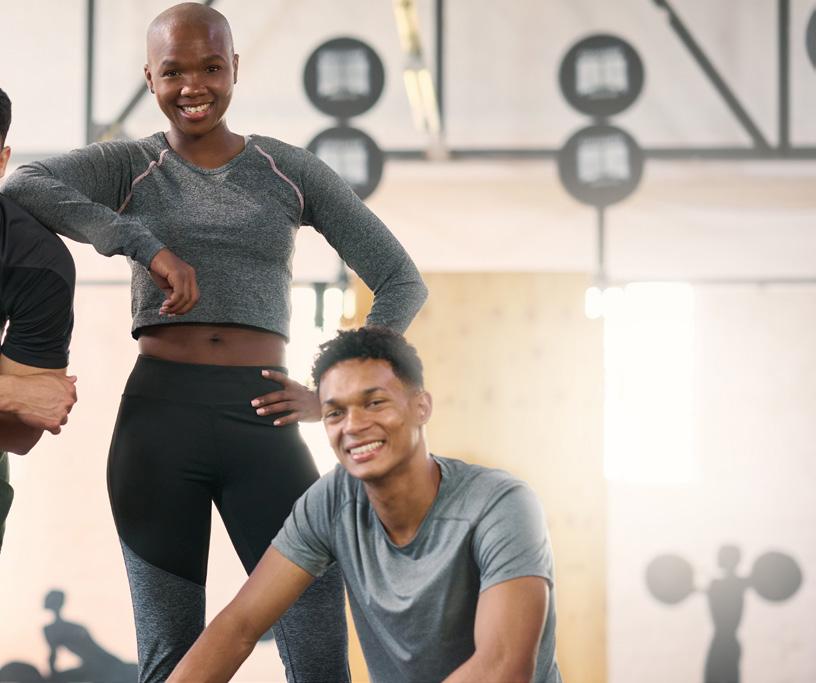
25 canfitpro March/April 2023
regularly. The study concluded that weekly group fitness classes could be a solution for improving the emotional well-being and stress level of medical students.

How to engage and inspire: Curate experiences!
The fitness experience in 2023 and beyond is far more than the minutes we spend in the gym. It is a community. Why not think about hosting special promotions for healthcare professionals or an outdoor event for your members? We want “gym friends” and sometimes it is as simple as going the extra mile to make sure that they have opportunities to meet and socialize beyond the sweat! If you have a juice bar or a coffee shop close, see if they will offer a discount to your members. We have seen more LIVE WELL friendships fostered outside our gym walls than within!
3. The cognitive and mobility benefits of group fitness for seniors.
Many of our LIVE WELL members are over the age of 55, and say repeatedly, “I do not simply want to get older. I want to live my life to the fullest. I want to be able to play with my grandchildren; I want to live independently for as long as possible. I want to get up and down stairs, and I do not want to be a burden to my kids.” This is a powerful reason to help our clients get active.
Two key pieces of research highlight the benefits of group fitness for our aging population. In the United Kingdom, the REACT study researchers tested the impact of regular group exercise sessions for people over 65, following them for one year, to determine whether or not their mobility improved. Low levels of physical activity are linked with frailty in older people, which impacts quality of life. The study was an inexpensive, easy-toimplement program that aimed at changing behavior, through group fitness classes that focused on strength, balance, cardiovascular gains, and mobility in a fun and social setting. A year after the program ended, researchers compared the mobility levels of the exercising group,
canfitpro March/April 2023 26

Solutions Designed to Support your Business BUSINESS MEMBERSHIP Becoming a Business Member is FREE Exclusive discounts and exclusive access for events Level up to a Gold membership to unlock additional business benefits Receive unique discount codes for you and your staff to stay certified, learn, and network Sign up as a recognized Host Facility for courses - and recruit top talent Contact us today to sign up canfitpro.com/fitness-business
LEVEL UP YOUR CUSTOMER RETENTION STRATEGIES
CREATIVE SOLUTIONS TO COMMON ISSUES FOR CLIENT LOSS
You have put in years of hard work to get your fitness business out there and build a brand. Not to mention the blood, sweat, and tears you have put into engaging potential customers and turning them into members at your studio. And now you have noticed that your member attrition (churn) rate is on the up. Do not worry. Now is not the time to panic. But it is the time to start thinking about your customer retention strategies.

Having strong client retention strategies are what will help you hold onto your customers once they have signed up, which is vital to the health of any business in the fitness industry, especially when you consider that it can be up to five times more expensive to get new members than it is to retain them!
Bear in mind that customer churn is natural to some extent. Clients’ workout needs will change, their budgets will
change, and their interests will change. But there are several steps you can take to adapt to changing members’ needs and maximize their lifetime value.
Here we identify four common issues that lead to client loss, and some creative solutions you can use to solve them.
Reason 1: The Dreaded Seasonal Slumps
In the fitness industry, there are two key

canfitpro March/April 2023 28
JOURNAL
seasonal slumps. With more people traveling, making the most of the pleasant weather outdoors, or just enjoying some down time, it is common for gym numbers to drop during the summer months. And it is a similar story near the end of the year when people are busy enjoying the holidays. People travel to see family, take time off to disconnect and prefer indulging in the festivities to working out. You cannot control the weather or cancel Christmas, but do not worry, there are much better ways to approach this problem.
One option is to incentivize or reward member activity during the seasonal slumps. For example, run a special campaign where you track your members’ visits and dole out rewards based on the number of visits they complete in a month. They could receive a free product, free personal training classes, or an exclusive discount.
Another option is to lean into the seasons and organize limited or exclusive events. For example, during summer you could offer outdoor group classes, swimming lessons, or spin up a running club. During winter, drum up some holiday spirit with a charity fundraising challenge or run a new and unique class, such as Tai Chi.
Reason 2: Your Studio Is At Capacity
While it might seem like a dream to have your studio creeping up on its maximum capacity, being so close to that threshold can have its challenges.
It is almost impossible to take on new customers when your studio or gym is bursting at the seams, and it is just as difficult to keep existing customers happy when they do not have the desired space they need for their best workout. The obvious solution here is to expand and open a new location, but we all know that this is much easier said than done. It will not happen overnight, and by the time it does you may have lost a lot more customers. As an interim solution, or a new permanent option, consider expanding your roster of hybrid or online-only services. Not only will it help your capacity situation, with the ability of technology to drive member engagement, going digital could also encourage more member activity than ever. Some people prefer the privacy of a home workout. Some clients may become more consistent with their exercise with the flexibility of doing it at a
time and in a place that suits them best.
The more comfortable your clients are, the more they work out. The more they work out, the happier they become. The happier they become, the more likely they are to stay a customer!
Reason 3: You Have Lost the “Personal” Touch
Personalization is an often overlooked element of customer retention, when in reality it is a highly effective method of creating repeat engagement and loyalty over time, especially for fitness studios. Where personalization can often feel most challenging is in your online training services, but with just a few small changes you can deliver hyperpersonalized experiences at scale.
Start with your services themselves and leverage your training app to build custom programs designed to your clients’ needs. Then, add an extra layer of personalization on top by scheduling in auto-messages for motivation, daily reminders, or check-ins. It will make them feel like their trainer is always with them, keeping a watchful eye, ready to support their every need. You can even use auto messages to wish clients a happy birthday to help them feel appreciated!
PS: Do not forget to thank your clients for all the support they show you throughout the year. Be sure they know just how much they mean to you.
Reason 4: Lack of Connection
Lots of people like to get their sweat on solo, but for many working out can be
a lonely affair. And when that sense of isolation creeps in, a client’s desire to exercise can fizzle out, along with their gym membership. This problem can easily be combated by putting time and energy into building a community. This can be done through group chats and group workouts or challenges. People working out together can spur each other on and bring together people of all levels. Having these open lines of communication between members is a wonderful way to share praise, welcome new members, and help members find and make friends.
Make a Long-Term Plan
At the end of the day, the best way to reduce your customer attrition rates, and to keep them low, is to create a long-term game plan. At Trainerize, we understand that most fitness business owners got into the industry to help people, not to be marketing and sales gurus.
So, we put together a game changing resource: The Ultimate Guide to Client Retention for Fitness Professionals. At Trainerize, we can help you achieve your business goals and deliver training and fitness services your members will love. By using our software, members will have more options to train with your trainers inside and outside the gym. They can deliver programs on your very own app and track clients’ progress in real-time. The app also allows trainers to engage with clients via direct messages or group chats -- helping to keep clients motivated and coming back.

Trainerize is a client engagement mobile app and software that allows fitness businesses and fitness professionals to expand their reach beyond their physical spaces, better connect with clientele, build meaningful relationships, and digitize the training experience. Fitness businesses use Trainerize to boost member engagement through digital services as well as attract new members by tapping into the market of online training. Visit trainerize.com
Founded in 1981, ABC Fitness Solutions (abcfitness.com) is the premier software and related services provider for the fitness industry. ABC helps over 20,000 clubs and facilities in 75 countries perform better and more profitably, offering a comprehensive SaaS (Software as a Service) club management solution that enables club operators to achieve optimal performance. ABC Fitness Solutions is a Thoma Bravo portfolio company; a private equity firm focused on investing in software and technology companies (thomabravo.com).

29 canfitpro March/April 2023
BECOME A PERSONAL TRAINING SPECIALIST


canfitpro.com/ personal-training-specialist GET CERTIFIED
THE GEAR TO HEALTH AND VITALITY: MOVEMENT
DEVELOPING THE SOCIAL CONSCIOUSNESS OF FITNESS AS UNIVERSALLY IMPORTANT
By Jess Silver
“IF YOU CAN’T FLY, THEN RUN. IF YOU CAN’T RUN, THEN WALK. IF YOU CAN’T WALK, THEN CRAWL, BUT BY ALL MEANS, KEEP MOVING.”
This quote, by Martin Luther King Jr., powerfully speaks to the importance of movement and realizing that everybody needs to move to feel and be healthy. It addresses the fact that everyone moves in unique ways, and that every
movement no matter how small it may seem, is crucial to helping to form larger functional movements.
Any physical movement is like a gear to one’s overall health, definition, and
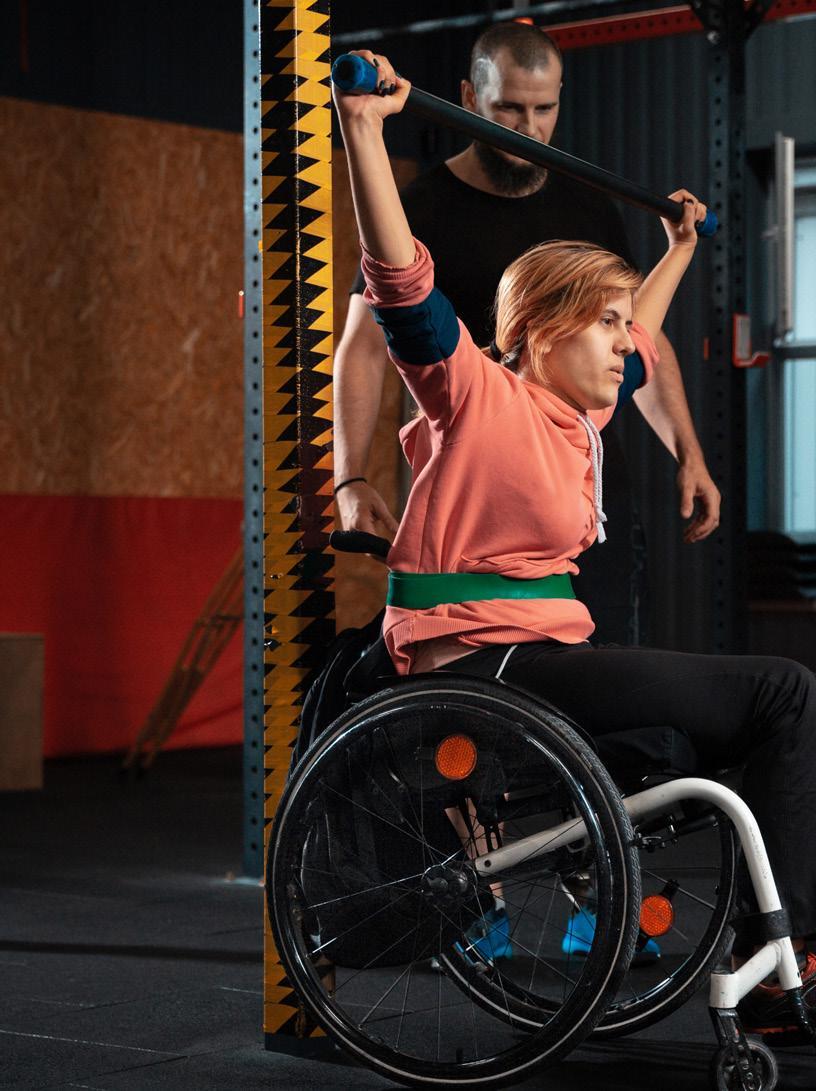
canfitpro March/April 2023 32
DIVERSITY, EQUITY & INCLUSION
embodied feeling of vitality. When one is moving their body, it is also important to think about the reactionary effect that it has on their mind. Movement can make one feel capable, empowered, strong, in control of a particular circumstance and/ or equipped to encounter and recover from unknown situations that may be characteristic of adversity. It also helps develop a thirst and skillset to retain new physical skills related to cognitive ones.
The relationship of movement as positively impacting every aspect of health is particularly important for fitness professionals, educators, and policy makers of the industry to realize and effectively develop programming for working with individuals with disabilities.

Firstly, many people do not realize that most people with physical disabilities are not active. For example, 93 percent of women with a physical disability do not participate in sport, according to a report published by Sport For Life in 2020. Secondly, there are a limited number of opportunities that readily exist within the mainstream for adaptive fitness and sport promotion. These realities further contribute to unhealthy conditions and a type of complacency which makes it acceptable within mainstream society to believe that individuals with disabilities cannot exercise and are not able to access mainstream fitness, yoga, or sport-based establishments. These are problematic notions because they further




propagate attitudinal discrimination and apprehension towards allowing individuals with disabilities to fully participate as active citizens in society, in general as well as specifically in fitness and sport. This in turn creates an environment which conditions the individual who has challenges, physical or intellectual, visible, or invisible to feel like they cannot be physically active, which increases their physical atrophy and decline in mental health.
management of prolonged muscular, joint, and systemic atrophy. The number of opportunities and access to education and knowledge translation for adaptive athletes, and those who have varying abilities, are not readily accessible and accepted within mainstream settings. It is necessary that this systemically change by allowing for leadership opportunities of professionals within the adaptive fitness space to coincide with those in the mainstream fitness industry. This will create a more informed industry and allow for individuals with physical disabilities, and other challenges, to feel accepted, engaged and empowered to consistently participate in exercise and wellness regimens.



A shift in social consciousness needs to occur within the fitness industry. Fitness professionals have both an important responsibility and role to become leaders of developing new programming for movement tailored for individuals with varying abilities, and to educate other health professionals on the transformative role that fitness has in disability management. It is time that engaging in fitness-based training is not perceived as solely a competitive activity, but that it be understood and applied as a preventative measure to chronic conditions, permanent disability, and the
Jess Silver is a medical writer, motivational speaker, Adaptive Fitness personal trainer and Founder of Flex for Access Inc., a nonprofit organization for fitness and sport promotion to manage


33 canfitpro March/April 2023
... 93 PERCENT OF WOMEN WITH A PHYSICAL DISABILITY DO NOT PARTICIPATE IN SPORT...
UNDEREATING MAY BE SABOTAGING CLIENT GOALS
PROTECTING OUR METABOLISM FOR BODY COMPOSITION CHANGES
By Angela Wallace, MSc, RD

NUTRITION
canfitpro March/April 2023 34
WHEN
I find this particularly challenging with women. Men are often encouraged and expected to eat substantial amounts of food, while women are told the opposite. Women often experience feelings of guilt for eating larger portions and are more likely to follow restrictive diets. In fact, most North American dieters each year are women (over 55 percent).
It is typical for women to avoid carbohydrates and undereat in the hopes of quickly reaching their weight loss goals. When doing a quick weight loss search on the internet, you will see tons of 1200 calorie meal plans for women trying to lose weight. I would argue that 1000-1200 calories are the daily caloric needs of a toddler, not a grown adult woman. In fact, not eating enough can do the opposite of helping someone to lose weight. It can hinder weight loss, fat loss, muscle gain, and decrease energy levels. Undereating can be just as problematic as overeating when it comes to weight loss and body composition.
To support weight loss, the client must be in a caloric deficit. However, it is important to consider what amount of deficit will help support your client in achieving maintainable weight loss. Typically, a maintainable deficit ranges between 250-500 calories per day. When I work with women looking to lose weight, I try not to create a deficit of more than 350-400 calories, as I often find that going beyond that will lead to shifts in their metabolism.
Undereating shifts our metabolism

Our bodies are subject to homeostatic control, meaning our body always wants to be in a state of balance where it feels safe, comfortable, and can function optimally. An example of the body’s homeostatic control regulation is body temperature. If our core temperature rises, our body will begin to sweat to release the heat from our core and cool our internal temperature. This homeostatic control also influences our metabolism, where large deficits in calories can elicit changes in our metabolism.
Metabolism can be defined as the sum of all chemical processes that take place within your body to sustain life. To drive these processes your body requires fuel, aka food. When chronically undereating, the body will slow down all processes to stay as efficient as possible, meaning fat loss is not a main priority.
Alternately, as you exercise and begin to gain muscle, your metabolic rate (or metabolism) will increase. However, if you do not meet this increased energy demand by eating enough food your metabolism will slow down and try to use what it is given while conserving energy and fat.
In addition to shifts in metabolism, undereating can create shifts in hormone production. When you do not eat enough your body reduces sex hormones, thyroid hormone, and increases production of stress hormones, such as cortisol. Overtime, these hormonal shifts can lead to water retention, difficulty losing weight, increased fat mass, and health concerns. It also influences your hunger hormones, creating increased appetite and less indication of fullness.
Some symptoms associated with undereating:
• Difficulty sleeping
• Low energy levels
• Exercise feels really challenging (more than usual)
• Mood swings
• Brain fog, confusion
• Depression/anxiousness/change in mental state
• Constipation
• Hair loss
• Low sex drive
Working with a client who wants to lose weight
Make sure they are eating enough to fuel their daily activities and the workout regimen they are hoping to follow. If they are experiencing any of the symptoms above, have them re-evaluate what they are eating. They may benefit from additional nutrition support, get them to seek guidance from a nutrition professional. This is particularly important if their undereating is intentional and concerning.

There are general ways to calculate caloric needs, however it is important to assess other factors including the client’s level of stress, daily work activities, physical output, and sleep. Their lifestyle will contribute to their total caloric needs.
Bottom line
When you are undereating and in an extreme calorie deficit (more than 500 calories per day) your body will begin to prioritize what is needed for survival rather than rebuilding muscle. So even if a client is working hard exercising and following a calorie deficit, they may not be seeing any real changes to body composition, especially when it comes to muscle gain. When not fueling your body properly it also becomes difficult to train, the intensity will feel more challenging than it is because they are underfed.
Remember, the number of calories each person needs varies and finding the right amount to fuel their body can take some time. Encourage your clients to experiment with types of foods and quantities to help them feel their best. And remind them that undereating will not fuel their body or help them achieve maintainable body changes.
Angela Wallace is a registered dietitian, canfitpro personal trainer and Pilates instructor. She specializes in nutrition for women and children. Angela loves helping women feel their best, from the inside out. Follow her on IG @nutrition.for.families
IT COMES TO LOSING WEIGHT, MANY PEOPLE DO NOT KNOW WHAT EATING “ENOUGH” FOOD LOOKS LIKE.
35 canfitpro March/April 2023
IN ADDITION TO SHIFTS IN METABOLISM, UNDEREATING CAN CREATE SHIFTS IN HORMONE PRODUCTION.
HEALTHY NUTRITION, HAPPY BRAIN


 By Carol Harrison, RD
By Carol Harrison, RD
THE ROLE OF NUTRITION
BRAIN HEALTH
ON
NUTRITION canfitpro March/April 2023 36 THIS ARTICLE IS ELIGIBLE FOR TO TAKE THE QUIZ LOG INTO YOUR MEMBER PROFILE AT canfitprointeractive.com 1 CEC LA LECTURE DE CET ARTICLE VOUS DONNE ACCÉS À GRÀCE AU QUIZ DISPONIBLE AU can tprointeractive.com DANS VOTRE PROFIL DE MEMBRE. 1 CEC
Recently, I asked a few fitness leaders what questions they have about nutrition and brain health. Here is what they wanted to know.
“I know physical activity is important for brain health, but does what you eat really matter for brain health?”
In a word, yes! Considerable research has shown the significant role that nutrition plays in brain and mental health. For example:
• Nutrition is one of the six pillars of brain health (the others being physical activity, mental exercise, social interaction, ample sleep and relaxation, and control of vascular risk factors). Food provides the nutrients necessary for proper brain function, including the building blocks to repair and maintain brain tissue.
• The brain is a hungry organ! Sending and processing signals all day long takes a lot of energy. That is why the brain uses about 20 percent of our body’s total daily energy.
• An undernourished brain could lead to poor cognitive function and mood instability—just think how “hangry” people can get if they go too long without eating.
• In the long term, poor nutrition can increase the risk for brain disorders such as Alzheimer’s disease and other forms of dementia. Eating a healthy diet can reduce your risk of diabetes, stroke, and heart disease, all of which are risk factors for dementia.
“What’s the single most important nutrition tip I can share with my fitness clients when it comes to nutrition and brain health?”
The brain is an active organ with substantial energy and nutrient
needs—so we should feed it well!
The media often reports on single “brain superfoods” such as berries or walnuts but given the variety of nutrients required for optimal brain health it is our overall dietary patterns that matter most. Focus on eating a wide variety of highly nutritious foods. A straightforward way to do that is to follow the healthy plate approach: ½ veggies and/or fruit, ¼ quality protein, ¼ whole grains.
That may sound basic, but the reality is that most Canadians do not eat that way. Far too many of our calories (46 percent) come from ultra-processed foods that tend to be nutrient-poor and pro-inflammatory (soft drinks, chips, cookies, etc.), and we are not eating enough nutrient-rich foods containing the wide variety of nutrients needed for optimal brain health, like fatty fish, dark green and orange vegetables, fruit, beans, beef, fermented foods (kefir, kimchi, miso), eggs, nuts, seeds, whole grains, yogurt, lentils, and tofu.
“Would switching to a plantbased diet be beneficial?”
No doubt most people would benefit from eating more whole and minimally processed plantsourced foods.
Research on diets that have brain-health benefits, such as the Mediterranean diet, the DASH diet, and the MIND diet, are often misrepresented as being free of animal-based foods. In fact, they are plant-forward and include animal-based foods that are rich sources of bioavailable nutrients vital for brain health—for example, mineral-rich lean meats that offer vitamin B12, iron and zinc; fish high in omega-3 fats; and eggs rich in choline.
A better question might be: What should come off our plates to make room for more whole and minimally processed plant-based foods? And for better brain and overall good health, the obvious answer would be ultra-processed foods.
ULTRA-PROCESSED FOODS AND DEMENTIA RISK: WHAT DOES THE RESEARCH SAY?
Higher consumption of ultra-processed foods (UPF) is associated with a higher risk of dementia, according to a large study published in Neurology in 2022. Ultra-processed foods include soft drinks, candy, frozen pizza, protein bars, chips, hot dogs, and a wide range of other products that tend to be low in nutrients and high in calories, fat, sodium, sugar, and additives.
The researchers used the UK Biobank, a database of genetic and health information for half a million people in the United Kingdom, to find 72,083 participants aged 55-plus who did not have dementia. The study tracked this cohort for an average of 10 years, during which participants completed at least two 24-hour dietary questionnaires.
By March 2021, when follow-up ended, 518 people had developed dementia—287 were diagnosed with Alzheimer’s disease, and 119 with vascular dementia. The study does not prove that UPF causes dementia, only an association between the two, but researchers concluded that people who consumed the most UPF may be at higher risk for dementia than those who consumed the least. After adjusting for age, gender, family history, and other factors, they found that for every 10 percent increase in daily intake of UPF, the risk of dementia was 25 percent higher.
Here is the good news: Swapping out UPF for healthier foods can lower the risk of dementia, researchers found. Replacing 10 percent of UPF with an equivalent amount of unprocessed or minimally processed foods like fresh fruit, vegetables, legumes, milk, and meat “was estimated to be associated with a 19 percent lower risk of dementia.”
Carol Harrison is a registered dietician who loves her daily workouts! She has a food nutrition communications company in Toronto. For more recipes, healthy hacks or article suggestions, connect with Carol on IG @CarolHarrison.RD

37 canfitpro March/April 2023
THE BRAIN IS THE COMMAND CENTRE AFFECTING ALL ASPECTS OF OUR DAILY LIVES, SO KEEPING IT HEALTHY IS VITAL FOR OVERALL HEALTH AND LONGEVITY.
ALIMENTATION SAINE, CERVEAU



LE RÔLE DE L’ALIMENTATION DANS LA SANTÉ CÉRÉBRALE
HEUREUX ! Par Carol Harrison, nutritionniste NUTRITION canfitpro March/April 2023 38 THIS ARTICLE IS ELIGIBLE FOR TO TAKETHE QUIZ LOG INTO YOUR MEMBER PROFILE AT canfitprointeractive.com 1 CEC LA LECTURE DE CET ARTICLE VOUS DONNE ACCÉS À GRÀCE AU QUIZ DISPONIBLE AU can tprointeractive.com DANS VOTRE PROFIL DE MEMBRE. 1 CEC
LE CERVEAU EST LE CENTRE DE COMMANDEMENT. C’EST DE LÀ QUE PARTENT LES COMMANDES AYANT UN IMPACT SUR TOUS LES ASPECTS DE NOTRE VIE QUOTIDIENNE.
Recently, I asked a few fitness Le maintenir en santé est vital pour notre santé globale et notre longévité. Récemment, j’ai demandé à quelques-uns des joueurs clés de l’industrie du conditionnement physique ce qu’ils ou elles aimeraient savoir à propos de l’alimentation et de la santé du cerveau. Voici donc quelques-unes des questions posées :
« Je sais que l’activité physique est importante pour la santé du cerveau, mais est-ce que ce que nous mangeons a vraiment une importance pour la santé cérébrale ? »
En un mot, oui ! De nombreuses études ont démontré le rôle déterminant que l’alimentation joue dans la santé cérébrale et mentale. Par exemple :
• L’alimentation est l’un des six piliers de la santé cérébrale (les autres étant l’activité physique, l’exercice cérébral, l’interaction sociale, le sommeil et la relaxation en quantité suffisante, et le contrôle des facteurs de risques cardiovasculaires). La nourriture apporte des nutriments nécessaires à une bonne fonction cérébrale, incluant les substances fondamentales permettant de réparer et d’entretenir les tissus cérébraux.
• Le cerveau est un organe affamé ! Envoyer et traiter des signaux toute la journée demandent beaucoup d’énergie ! C’est pourquoi le cerveau utilise environ 20 % de l’énergie totale quotidienne de notre corps !
• Un cerveau sous-alimenté pourrait entrainer une mauvaise fonction cognitive et une humeur instable (ne faites que penser à quel point une personne est irritable lorsqu’elle est affamée…).
• À long terme, une mauvaise nutrition peut augmenter les risques de troubles cérébraux comme la maladie d’Alzheimer et d’autres formes de démence. Avoir une bonne nutrition peut réduire les risques de souffrir de diabète et de maladies cardiaques ; lesquelles maladies sont également des facteurs de risque associés à la démence.
« Quel est le conseil le plus important à donner à mes clients et clientes en matière de nutrition et de santé cérébrale ? »
Le cerveau est un organe actif avec d’importants besoins en termes de nutriments et d’énergie, il est donc important de bien le nourrir !
Les médias font souvent référence à un seul superaliment pour le cerveau comme les baies ou les noix, mais vu la variété de nutriments nécessaires à une santé cérébrale optimale, ce qui est vraiment important, ce sont nos habitudes alimentaires globales. Visez une alimentation variée hautement nutritive. Une façon simple d’y arriver est de suivre l’approche de l’assiette équilibrée, c’està-dire : 1/2 de légumes et de fruits, 1/4 de protéines de qualité, et 1/4 de grains.
Cela peut paraître simple, mais la réalité est que la plupart des Canadiens ne mangent pas de cette façon. Beaucoup trop de nos calories (46 %) proviennent d’aliments ultratransformés pauvres en nutriments et inflammatoires (boissons gazeuses sucrées, croustilles, biscuits, etc.), et nous ne mangeons pas suffisamment d’aliments qui contiennent une grande variété des nutriments nécessaires à une santé cérébrale optimale comme des poissons gras, des légumes verts foncés ou orangés, des fruits, des légumineuses, du bœuf, des aliments fermentés (kéfir, kimchi, et miso), des œufs, des noix, des grains entiers, du yogourt, des lentilles, et du tofu.
« Est-ce que changer notre alimentation pour une diète végétarienne serait bénéfique ? »
Il n’y a aucun doute que la plupart des gens gagneraient à manger plus d’aliments d’origine végétale entiers et peu transformés.
Les recherches sur les régimes alimentaires favorisant la santé cérébrale, comme la diète méditerranéenne, la diète DASH, et la diète MIND, sont souvent faussement représentées comme étant exemptes d’aliments d’origine animale. En fait, ces régimes sont axés sur les aliments d’origine végétale, mais incluent également des aliments d’origine animale qui sont une source importante de nutriments biodisponibles essentiels à la santé cérébrale, comme les viandes maigres riches en minéraux qui contiennent de la vitamine B12, du fer, et du zinc ; le poisson riche en oméga-3, et les œufs riches en choline.
Une meilleure question serait : que devrionsnous enlever de nos assiettes pour laisser plus de place à des aliments d’origine végétale entiers et peu transformés ? Et pour une meilleure santé cérébrale et globale, la réponse évidente serait : les aliments ultratransformés.
LES ALIMENTS ULTRATRANSFORMÉS ET LES RISQUES DE DÉMENCE : QUE DISENT LES RECHERCHES ?
Selon une importante étude publiée dans le journal Neurology en 2022, une alimentation comprenant une grande quantité d’aliments ultratransformés est associée à un plus grand risque de démence. Les aliments ultratransformés incluent les boissons gazeuses sucrées, les friandises, les pizzas surgelées, les barres protéinées, les croustilles, les hot-dogs, et une grande variété d’autres produits qui tendent à être pauvres en nutriments, mais riches en calories, gras, sodium, sucres, et additifs.
Les chercheurs ont utilisé la UK Biobank, une base de données contenant des informations génétiques et sanitaires sur un demi-million de personnes au Royaume-Uni afin de trouver 72 083 participants âgés de 55 ans et plus qui ne souffraient pas de démence. L’étude a suivi cette cohorte sur une période moyenne de 10 ans, pendant laquelle les participants et participantes ont rempli au moins deux questionnaires portant sur ce qu’ils ou elles mangeaient sur une période de 24 heures.
En mars 2021, lorsque s’est terminé le suivi, 518 personnes avaient développé de la démence (287 ont été diagnostiquées avec la maladie d’Alzheimer, et 199 avaient quant à elles développé une démence vasculaire). L’étude ne prouve pas que les aliments ultratransformés provoquent la démence, elle ne peut qu’établir un lien entre les deux, mais les chercheurs ont conclu que les personnes ayant consommé le plus d’aliments ultratransformés pouvaient présenter un risque de démence plus élevé que celles qui en avaient moins consommés. Après avoir pris en compte l’âge, le sexe, les antécédents familiaux, et autres facteurs, ils ont constaté que pour chaque augmentation de 10 % de la consommation quotidienne d’aliments ultratransformés, le risque de démence augmentait de 25 %.
Voici les bonnes nouvelles : les scientifiques ont constaté qu’échanger les aliments ultratransformés pour des aliments sains peut réduire le risque de démence.
Remplacer 10 % d’aliments ultratransformés pour une quantité équivalente d’aliments non transformés ou très peu transformés comme des fruits frais, des légumes, des légumineuses, du lait, et de la viande ont été associés à une diminution de 19 % des risques de démence.
Carol Harrison est une nutritionniste diplômée qui adore ses entrainements quotidiens ! Elle possède une entreprise en communication de l’alimentation à Toronto. Pour obtenir des recettes, des astuces santé, ou des suggestions d’articles, connectez-vous au compte Instagram de Carol au @CarolHarrison.RD

39 canfitpro March/April 2023
WHAT’S FUELING TEENAGE ATHLETIC PERFORMANCE?

THE DANGERS OF SUPPLEMENTS AND EFFECTS OF MISUSE
By Christine M. Conti, M. Ed. Co-contributor, Makenna Ellis
NUTRITION
canfitpro March/April 2023 40
WHO DOESN’T WANT TO WIN?
Since the beginning of mankind, the drive to survive and thrive in an often hostile environment has been second nature. And while one may no longer need to outrun a tiger or fight a bear with their bare hands, the drive to gain an edge over opponents is still very much alive, especially at the high school and collegiate levels. Performance enhancing drugs and supplements are on the rise, and the pressure to win, overcome training plateaus, keep up with body images portrayed on social media, or earn a college scholarship is tougher than ever.
As a result, teens are becoming desperate “to increase muscle strength, keep the body alert, and boost athletic performance.” Unfortunately, what teens do not know is that many performance enhancing drugs and supplements are not approved by the FDA and may cause long-term side-effects.
In a recent double-blind social media poll, one hundred teenagers between the ages of 13 and 19 were surveyed about drug and supplement use. Out of the 92 teens that described themselves as avid “athletes”, 65 percent of ALL teens reported using at least one or more forms of supplements in order to enhance athletic performance. In fact, close to 50 percent of teen athletes reported taking supplements daily or even multiple times throughout the day, but only half of the teens were aware of any possible long-term side-effects.
In addition, 75 percent of teens said that they would NOT use performance enhancing drugs or supplements if they knew they caused irreversible damage to their body. However, the most shocking finding is that over 80 percent surveyed reported that a teacher, coach, or trainer had NEVER spoken to them about any dangers associated with using performance enhancing drugs or supplements.
It is time to act
As fitness professionals and coaches, it is your responsibility to learn about the possible side-effects of the most used performance enhancing drugs and supplements. Only then can you openthe-dialogue about the hidden dangers of supplementation and the negative

effects they can have on both the mind and the body.
So, what are teenagers really doing to fuel their athletic performance?

According to “Operation Supplement Safety,” an up-to-date website developed by the United States Department of Defense, teen athletes are overusing creatine, caffeine, and protein/amino acid supplements at an alarming level. Not surprisingly, recent marketing that appeals to teens in the form of shakes, bars, drinks, and pills seem harmless, but misusing any supplement has consequences. Below are some of the most popular types of supplements used by teens and effects of misuse. It is time to open the dialogue on the dangers of supplements, and it begins with you!
called adenosine, responsible for dilating blood vessels in the head. Caffeine blocks this dilation…your body becomes overly sensitive to adenosine, blood vessels dilate, creating pounding headaches.
3. Misuse of caffeine causes a racing heartbeat, heart palpitations, shortness of breath, anxiety, mood swings, insomnia, increased appetite, and more.
Additional reading here
Protein Supplements:
1. Protein requirement for teenagers ages 14-18:
a. Boys 52 grams of protein
b. Girls 46 grams of protein
2. Too much protein causes:
a. Excess calories stored as fat if not burned off
b. Organ damage such as kidney stones, dehydration, diarrhea, constipation, poor digestion, bad breath, and more.
3. Long-term effects:
a. Kidney damage, certain cancers, heart disease, calcium loss, and more.
Additional reading here
Creatine Supplements:
1. The American Academy of Pediatrics and the American College of Sports Medicine advise against using performance-enhancing supplements, including creatine, among teenagers.
2. Misusing creatine by taking more than the recommended amount can lead to heart, kidney, and liver damage.
3. Creatine disrupts water levels in the body leading to dehydration and poor kidney function, interrupts sleep patterns, increases mood swings, and causes bloating and stomach discomfort.
Additional reading here
Caffeine Supplements:
1. Teens should not have more than about 100mg of caffeine a day, which is equivalent to one cup of coffee or about two cans of soda.
2. Caffeine is very similar in structure to another chemical in our body
Christine Conti, M.Ed., is a best-selling author, international chronic disease and fitness educator, motivational speaker, podcaster, and ultraendurance athlete. Christine co-hosts the Two Fit Crazies and a Microphone Podcast, she is a 3x Ironman, 100 Miler, chronic disease warrior, and her signature bestselling book, Split-Second Courage, was released in 2022.
Makenna Ellis is a sophomore advanced placement scholar athlete at Brick Memorial High School in New Jersey. She competes yearround in cross country and track and field and has a newfound love for fitness and nutrition. She plans to continue her education and become a registered dietitian.

41 canfitpro March/April 2023
...THE PRESSURE TO WIN, OVERCOME TRAINING PLATEAUS, KEEP UP WITH BODY IMAGES PORTRAYED ON SOCIAL MEDIA, OR EARN A COLLEGE SCHOLARSHIP IS TOUGHER THAN EVER.
MOOD BOOSTING FOODS
PLANT-BASED NUTRIENTS TO IMPROVE MENTAL WELLNESS
 By Lorne Opler
By Lorne Opler
NUTRITION
canfitpro March/April 2023 42
An abundance of research has proven that exercise has a positive impact on our mental health and shows substantial benefit for reducing anxiety and depression. Yet in the discussion of natural interventions to boost mood, one topic is most often overlooked. Food. Yes, food. Because there is evidence-based data to show that the foods we eat also beneficially impact our mental health. Which foods are the best for boosting mood is the focus of this article. And research shows that plant-based foods provide a substantial amount of nutrients to improve mental wellness. One of those nutrients, for example, is a class of compounds called phyto (meaning “plant”) chemicals.

How the brain operates is through a densely packed networked of cells called neurotransmitters. These cells transmit signals that allow us to think and interpret the world around us. If neurotransmitters get thrown out of balance, for example due to depressive illness, plantbased foods can assist in repairing neurotransmitters. How so?
Beyond neurotransmitters, the brain also contains many enzymes which are protein structures that accelerate the many chemical reactions that occur in the brain. One enzyme found in the brain is called monoamine oxidase (MAO). Many people who live with depressive illness have higher than normal levels of MAO because MAO dismantles several
brain neurotransmitters that elevate mood – serotonin, dopamine, and norepinephrine. A deficiency in these neurotransmitters has been posited as a cause of depressive illness. But one phytochemical in particular has been shown to reduce levels of MAO, and consequently boost levels of the anti-depressive neurotransmitter’s serotonin, dopamine, and norepinephrine. That phytochemical is called quercetin. Quercetin is found in many fruits and vegetables including kale, broccoli, blueberries, onions (especially red and yellow varieties), green tea.
But eating tryptophan high foods alone is not an efficient way for tryptophan to cross the blood/brain barrier for conversion to serotonin. Especially if your meal contains other proteins which, when broken down into their own amino acid constituents, will compete with tryptophan to reach the brain. But when you combine foods high in tryptophan along with a whole grain, the carbs will trigger the release of insulin, insulin will transport the competing amino acids into muscle tissue, and tryptophan can pass unrestrictedly into the brain. So next time you are eating any protein, combine it with a carb (think turkey on whole wheat or hummus on whole grain crackers) to maximize the transport of tryptophan into the brain.

Let us look at serotonin. While it is a proven neurotransmitter responsible for elevated mood, you cannot get it from diet. There are no foods themselves that contain serotonin. However, there are foods that contain a precursor (or building block) for serotonin and that precursor is called tryptophan. When you consume foods high in this amino acid, the tryptophan will be converted into serotonin in the brain (after crossing over the blood/ brain barrier) and then utilized for its anti-depressive effects. Foods high in tryptophan are both animal and plant based. Animal sources of tryptophan include chicken, turkey, tuna fish, cottage cheese, and milk (especially whole milk and 2% milk). Plant based sources include peanuts, pumpkin and sunflower seeds, hummus, tofu, and soy products.
Lorne Opler, M.Ed., CSCS, is an Adjunct Professor at Seneca College in Toronto, Ontario where he teaches Introductory Nutrition. He has specific interests in the areas of exercise and mental health, nutrition and mental health, fitness for older adults and people with disabilities. His freelance fitness articles appear in Muscle and Fitness magazine, ACE Fitness, and the Washington Post. Visit his website at www.trainerlorne.com
WITH SO MUCH ATTENTION BEING RIGHTLY PAID TO MENTAL HEALTH ISSUES THESE DAYS, MANY OF US ARE AWARE OF THE RELATIONSHIP BETWEEN EXERCISE AND GOOD MENTAL HEALTH.
43 canfitpro March/April 2023
MANY PEOPLE WHO LIVE WITH DEPRESSIVE ILLNESS HAVE HIGHER THAN NORMAL LEVELS OF [MONOAMINE OXIDASE] …
These resources combine expert strength training, injury prevention, and yoga advice with exceptional full-colour artwork!



@HumanKineticsCanada

Connect with us on Facebook to be the first to know about upcoming promotions and giveaways.

@HumanKineticsCanada Canada.HumanKinetics.com
Movement in many forms is the key to building and maintaining a healthy body and mind as you age. Get a renewed outlook on what it means to be fit with Total Body Beautiful.

This resource explains how different bodies manage various exercises and how to best take advantage of physical attributes to optimize those movements.

Approved and endorsed by TRX®, this book offers 100 TRX-based exercises, 40 variations, and 24 ready-to-use programs designed to take your workouts to the next level.
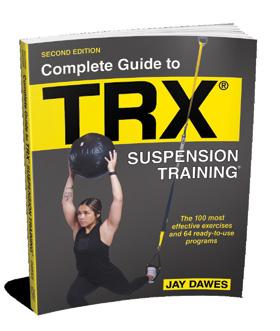

This is the most comprehensive resource available for individuals working with young athletes.

Learn how to train your breathing patterns to achieve your ultimate athletic potential.

Based on the latest science and research, this book details physical training, nutrition, and injury prevention for all martial arts disciplines.

Your #1 source for fitness and health resources info@hkcanada.com 1-800-465-7301
releases!
New
FLUID AND SODIUM NEEDS DURING EXERCISE

THIS IS AN EXCERPT FROM HIGH PERFORMANCE NUTRITION FOR MASTERS
ATHLETES, BY LAUREN ANTONUCCI

EXCERPT
canfitpro March/April 2023 46
Doing so will help maintain heart rate, stroke volume, cardiac output, skin blood flow, core body temperature, rating of perceived exertion (RPE), and overall performance. You are probably aware of the health risks associated with heat stress and heat illness due to exercising in extreme heat, but performance will generally suffer as a result of dehydration long before those two dangerous conditions become a concern. In addition, many athletes do not fully comprehend the far-reaching adverse effects of dehydration including exacerbated strain on our cardiovascular system, decreased blood flow to the brain, elevated core temperature, increased skeletal muscle glycogen use, increased fatigue and decreased mood and brain function (Sawka, Cheuvront, and Kenefick 2015). Fluid losses will generally be lower when you are exercising in a cooler environment, as will your body’s
tolerance for withstanding the state of underhydration (ACSM et al. 2007). However, environmental heat stress increases our body’s sweat rate response and fluid losses through our skin to keep our body cool. When exercising in humid environments, our skin is damp, which decreases our initial sweat response, increasing the chances of our bodies overheating. Over time, a training response occurs as we acclimate to training and racing in the heat by producing a higher volume of sweat to keep cool (ACSM et al. 2007).
Upon initial training, introduction to the heat, or anytime an athlete becomes acutely dehydrated, the body increases the sweat concentration of sodium and chloride in order to conserve fluids. However, over time, heat acclimatization occurs, leading to increased total sweat rate and decreased sodium content of sweat by up to 50 percent for any individual athlete (ACSM et al. 2007).
While neither sweat rate nor electrolyte concentration of sweat are predictable by knowing an athlete’s gender or age alone, an increase in ambient temperature results in a near-universal impairment in aerobic performance across all athletes (Sawka, Cheuvront, and Kenefick 2015). However, since the extent to which sweat rate and performance deterioration occur varies widely, each athlete’s output and needs require individual consideration and investigation. It is generally understood that most athletes’ hydration goal should be to customize their fluid replacement plan in order to prevent less than 2 percent loss of body weight due to sweat in order to prevent degradation in performance. Many studies have shown that a decrease of 2 to 7 percent of body mass consistently decreases endurancetraining performance in distances beginning with 1,500 meters (Maughan and Shirreffs 2008). Performance deteriorates with dehydration even in temperate conditions but is greatly impaired when more than 2 percent body weight is lost, exercise session is longer than 90 minutes, or temperature exceeds 30°C (86°F). Team sport athletes are not immune to the effects of even low-level dehydration. One study showed that soccer skills test performance decreased by 5 percent in experimental conditions when no drinking was allowed compared to when athletes were allowed to consume fluids during activity (Maughan and Shirreffs 2008). Maughan and Shirreffs (2008) also show that mild dehydration adversely affects mood and cognitive function.
Any loss of body weight exceeding 1 to 2 percent of pre-exercise weight requires further examination and discussion, since for most athletes, and especially for those performing in warm, hot, or high-altitude environments, even this seemingly small loss of body weight due to sweat has been shown to adversely affect performance (Sawka, Cheuvront, and Kenefick 2015). For example, time trial performance has been shown to decrease significantly in both male and female cyclists who were dehydrated to the point of having lost only 1 to 2 percent of their body weight (Logan-Sprenger et al. 2012; Logan-Sprenger et al. 2015). The authors’ conclusion is that high-intensity performance cannot be maintained when about 2 to 3 percent dehydration occurs. Possible mechanisms for this include not only the dehydration itself, but also an accompanying increase in muscle glycogen use in dehydrated athletes over the two-hour cycling trial. During their studies, male athletes were found to increase muscle glycogen use by up to 24 percent, while female athletes were found to increase muscle glycogen use by up to 31 percent, which alone can limit performance. The authors also noted increased heart rate by 4 to 9 beats per minute beginning at 20 minutes into the trial and continuing throughout, increased whole-body stress and reported feelings of decreased concentration, headaches, and increased RPE during exercise (Logan-Sprenger et al. 2012).
Maintaining close-to-baseline body weight from before to after training or competition also helps athletes avoid consequences of dehydration. Severe hypohydration is a concern for all athletes, because anytime 6 to 10 percent of body weight is lost due to sweating or fluid losses the athlete is at high risk for decreased cardiac output, decreased sweat production (and thus increased body temperature), decreased blood flow to skin and muscle, decreased performance and function, and increased risk of heat illness and heat stroke (ACSM et al. 2007).

Copyright © 2023 by Human Kinetics Publishers, Inc. Excerpted by permission of Human Kinetics, Champaign, IL. Available to order from Human Kinetics Canada at canada.humankinetics.com/ or by calling 1-800-465-7301.

MAINTAINING HYDRATION STATUS DURING EXERCISE AND COMPETITION IS ONE OF THE MOST IMPORTANT NUTRITIONAL STRATEGIES FOR ANY PERFORMANCE ATHLETE.
CORE OFF THE FLOOR
FUNCTIONAL EXERCISES TO STABILIZE AN UPRIGHT DYNAMIC POSTURE
 By Sarah Zahab, BSc., R. Kin, CEP
By Sarah Zahab, BSc., R. Kin, CEP
TRAINING
canfitpro March/April 2023 48
THERE ARE MANY FACTORS THAT WOULD GUIDE YOUR PROGRAMMING TO TRAIN YOUR CLIENTS AND GROUP FITNESS PARTICIPANTS’ CORE OFF THE FLOOR.
Your clients may be injured or physically cannot get on and off the floor due to various barriers. Perhaps you are looking for more functional positions to work your client’s core in movements that closely mimic our day-to-day activities. Or maybe you are working with ground-based athletes who need purposeful and specific upright core variations to help prepare them for the rigors of their sport.
Working our core off the floor can be an effective way to target, train, stabilize, strengthen, and integrate. As coaches, personal trainers, and group fitness instructors, we often stick to crunches, planks, and bugs but there are several efficient exercises that can be performed from a seated or standing position that can target the important multifidus, transverse abdominals, and obliques. We need our core muscles to stabilize us in upright dynamic postures. The following exercise examples can give you a starting point, provide ideas to customize exercises to your own groups, and give you a potential new perspective on training key areas.
Bent Over Bird Dog (stability ball/chair)
Instructions:
• Stand tall with shoulders over hips and feet under hips
• Press hands into the wall (or ball on the wall) with a small bend in elbows
• March slowly and alternate sides
• Try not to move the pelvis or spine (a good core connection will help stabilize the spine and pelvis)
• Maintain tall posture throughout the march
Banded/Cable Frontal Plane Stability
Press/Pallof Press
Instructions:
• Sit tall at the edge of a stability ball or chair
• Lift one foot off the floor and bring the knee towards the chest
• Press hands into knee on exhale
• Try not to move the pelvis or spine (a good core connection will help stabilize the spine and pelvis)
• Think of a same side press for an internal oblique focus and an opposite side press for an external oblique focus
Intructions:
• Stand tall in a bilateral stance facing away from band/cable
• Hold a band/cable directly above head with elbows bent at 90 degrees in front of you
• Exhale and extend arms overhead
• Stand with feet under hips or on one leg for a more challenging variation
Stability Ball Lateral Lean and Hold
Instructions:
• Stand tall and hip hinge forward, with a straight back, to place hands on a ball or chair (the ball can be placed against a post or step for more stability)
• Bend the knees slightly and tighten the core by thinking of wrapping in and up
• Exhale and extend one arm and the opposite leg
• Maintain the core cylinder, keep your spine straight and look down to align the cervical spine
Standing March
Instructions:
• Position one hip on the inside apex of ball
• Stagger feet against wall with your top leg back
• Toes point in the same direction, hips and shoulders are stacked
• Lean over the ball to place the body in a straight line and hold
• Focus on engaging the top side Quadratus Lumborum and obliques
Seated Knee Press (stability ball/chair)
You may find that these exercises do not “target” or load the core sufficiently. Your clients may not feel the same intensity when isolating muscles on the floor. Even though the above exercises may feel easier, trust that they are more integrated, compound, ground-based, and effective. Cueing a pre-contraction of the core unit may help to intensify the exercise. With all the exercises, ensure you maintain a strong cylinder with minimal spine movement. Exhalations can provide a good opportunity to engage and connect, while inhalations provide opportunities for release and let go. Aim to contract and release with each repetition to avoid rigidity and promote proper modulating and management of intra-abdominal pressure. You can begin with one or two exercises upright and still include floor variations for your clients or groups for an overall balanced plan.
Try getting off the floor and see what other movement patterns you can discover!
Sarah Zahab is a Registered Kinesiologist and Clinical Exercise Physiologist with a Health Sciences degree in Human Kinetics (honours) and over 22 years of fitness industry experience. Sarah is a former international fitness competitor and nationally ranked race walker. She owns Continuum Fitness and Movement Performance Inc., a multi-disciplinary clinic in Ottawa.

49 canfitpro March/April 2023
…[THESE] EXERCISES MAY FEEL EASIER, TRUST THAT THEY ARE MORE INTEGRATED, COMPOUND, GROUND-BASED, AND EFFECTIVE.
FIGHTING BACK TOGETHER: PARKINSON’S GROUP FITNESS
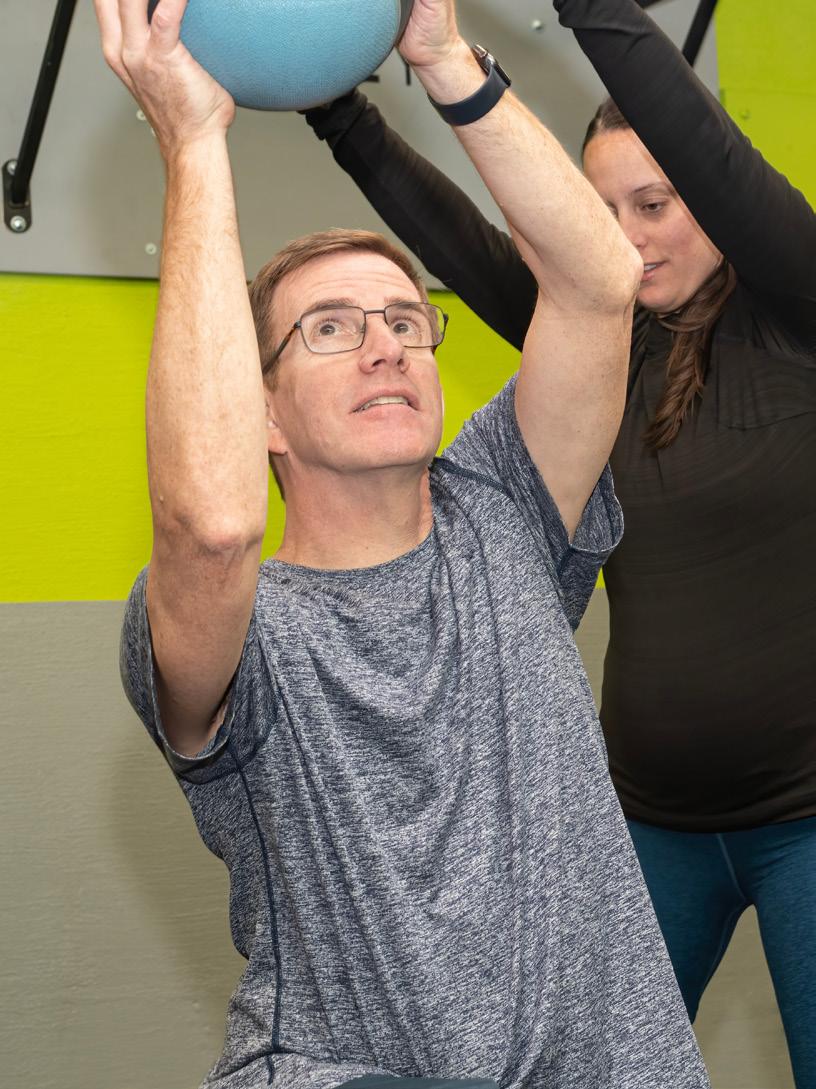
KEY TAKE AWAYS TO PROGRAM AN EFFECTIVE PARKINSON’S FITNESS PROGRAM
By Colleen Bridges M.Ed., NSCA-CPT
GROUP FITNESS
Parkinson’s Disease group fitness is one of the fastest growing programs in the fitness industry! This is good news, considering that every nine minutes someone is diagnosed with Parkinson’s Disease (PD). PD is a “progressive neurological disease that predominantly affects dopamine producing neurons in the substantia nigra.” The impact of dopamine loss causes motor symptoms ranging from rigidity, tremors, bradykinesia, and gait issues to secondary non-motor symptoms. Presently, there is not a cure for Parkinson’s. However, group fitness instructors can help keep Parkinson’s symptoms at bay through exercise and, at the same time, bring resilience to those suffering from this debilitating disease.
This is not your average group exercise class! Consider Parkinson’s Disease fitness part of our “fighters” (people living with Parkinson’s) medical regimen. When a doctor writes a prescription for medication, I would love to see a written prescription for exercise at the same time. Why? Because exercise IS medicine! Let us look at what makes an effective Parkinson’s group fitness program.
1. Become a Parkinson’s Disease Fitness Specialist
An instructor who understands the epidemiology of the disease, how medication works, potential side-effects, the best time of day for folks with PD to exercise, and which TYPE of exercise is most beneficial, will develop a long-lasting, effective program. Visit medfitclassroom. org to become a Parkinson’s Disease Fitness Specialist. (Save 25 percent on the course with coupon code canfitpro25. Course approved for four canfitpro CECs.)
2. Health assessment and class placement
PD is called the “Snowflake Disease” because, as with snowflakes where no two flakes have the same shape, no two people living with Parkinson’s have the same symptoms. Therefore, instructors need to perform a complete health assessment on each fighter, so they are prepared to provide modifications for a myriad of issues in each class.
Using the Hoehn and Yahr Scale, PD classes can be divided into levels so instructors can meet the needs of their fighters.
For example, Level ½ classes are best for those experiencing unilateral symptoms, and/or fighters who exercise regularly, can manage a vigorous class, and can selfmodify /challenge themselves.
Level ¾ classes are for those experiencing bi-lateral symptoms on a regular basis, cognitive decline, no previous exercise history and have a tendency to fall. We offer modifications for this level and fighters can opt to do the class in a chair.
TIP: Chairs, gait belts, and support coaches are recommended for level ¾.
and technique, then once most fighters are performing it correctly, begin to count reps.
a. TIP: Teach the exercise without equipment first to ensure proper technique and form.
5. Correct with compassion. People living with PD are self-conscious about their bodies. They avoid public gatherings due to tremor, drooling, hypophonia. The fact they have entered your classroom is an accomplishment. Additionally, some may always struggle with technique and form while others learn quickly, and this can lead to insecurity on the part of some of your fighters. The most important thing is to provide corrections to the entire class (unless someone is about to harm themself or another fighter) rather than to specific individuals.
3. Coach with clarity
Due to cognitive issues (PD dementia and Lewy Body Dementia) and complications processing information, an instructor’s delivery method needs to be clear and concise.
1. Mirror movements.
2. Build exercises. For example, before asking fighters (level ½ and ¾) to perform a squat/curl, start with the squat to correct any technique problems, then add the bicep curl.
a. Level ¾ class: the first set of exercises need to be taught while seated. Fighters can learn the exercises safely while also learning the modifications. Then repeat the exercises allowing your fighters to choose whether they stand or sit.
3. Provide strong direction. People living with PD need about five to 10 seconds (depending on how difficult the exercise) to process your command.
a. Example: to perform a walking “half-jack” with the right arm/leg, have them lift their right arm out to the side and step their right leg out to the side then start the exercise. You will see your fighters’ brains working, and they will comment on how much better they process information for 24-36 hours post class.
b. TIP: Give no more than one to two concise cues at a time.
4. Technique vs reps. Anxiety is increased when fighters feel rushed. Completing an exercise with confidence is essential. Instructors are encouraged to begin an exercise, cue proper form
a. TIP: When correcting fighters, tell the entire class “what you see being done” then show “what you want”. For example, if someone is rolling their back, show what that looks like then show a correct, straight back.
4. Connect
The above recommendations ONLY work when you connect with your fighters. Trust takes time, but an instructor who connects before/after class and when the fighter is absent will observe regular attendance, improving the fighter’s overall health and independence.
Each fighter has a life story but the one thing they ALL have in common is that when the doctor said, “You have Parkinson’s Disease” they did not back down! You can help them call on the fighter within, be victorious and experience hope for better days ahead!
TIP: Visit bridgesforparkinsons.com for more recommendations!
Colleen Bridges, M.Ed., is NSCA certified and holds numerous specialty certifications and continuing education related to helping those with neurological diseases. She is the author of the Parkinson’s Disease Fitness Specialist online course and creator of BridgesforParkinsons.com, an educational platform for personal trainers and coaches working with people living with Parkinson’s Disease.

51 canfitpro March/April 2023
...BRING RESILIENCE TO THOSE SUFFERING FROM THIS DEBILITATING DISEASE.
PARKINSON’S DISEASE GROUP FITNESS IS ONE OF THE FASTEST GROWING PROGRAMS IN THE FITNESS INDUSTRY!
SETTING THE STANDARD FOR CHILDREN’S FITNESS
QUALIFIED COACHES BUILD LIFELONG FITNESS ENTHUSIASTS
By Melanie Levenberg
CHILDREN ARE BORN TO MOVE, AND REGULAR PHYSICAL ACTIVITY HELPS THEIR...
…BODY, to develop strong bones and muscles, reduce stress and maintain healthy cardiovascular health.
…MIND, to improve focus, self-esteem, and confidence by giving children a safe place to release energy, face challenges, and learn new skills.
…SOCIAL connections, as an opportunity for social activities and to foster important skills such as teamwork, communication, and problem-solving.
As much as children need positive movement experiences, they also need qualified leaders to deliver these programs.
When it comes to children’s fitness, it is important to remember that children are growing and developing, and their bodies are different from adults. Therefore, having access to qualified coaches who
understand the unique needs of children when it comes to physical activity is critical to building lifelong movement enthusiasts.
What Exactly Does Children’s Fitness Look Like?
Do you struggle to picture yourself in a fitness studio, with twelve eight-year-olds screaming and running around? That is ok. There are many ways to get children ages seven to 12 active through a platform or class structure that you may be more familiar with, such as;
• 1:1 strength and weight training session in your home gym
• Stretch and mindfulness class during a P.E. class at a local school
• Sport and strength conditioning registered group program at a community centre
• A playful partner-based family fitness special event
• After-school “Active Kids” weekly group program
Opportunities to Upskill
If you are interested in teaching children’s fitness and movement classes, it is critical that you take the time to assess, adjust, and upskill on quality children’s fitness program elements that you may be missing. These include skill progressions, pacing of activities, use of non-traditional equipment, diversity of activity choices, effective instructional cueing, use of positive verbal coaching, and safety considerations.

Did you know that canfitpro recently released an updated Children’s Fitness Coach course? It includes updated information on children’s development, plus new and expanded practical activities, program lesson samples, and business set-up details for several types of children’s fitness programs, like the ones mentioned in the section above.
Remember that creating a safe and positive environment conducive to learning for children means providing a
canfitpro March/April 2023 52 CHILDREN’S FITNESS
balance between structured (instruction on proper technique and form) and unstructured (child-led activity design, collaboration, exploration, play) segments. This helps to reduce the risk of injury, as well as ensure that your physical activity program is effective and enjoyable for young children.
Building the Foundations for Healthy Generations
When working with a qualified children’s coach, children are developing positive mindset and attitude from their movement experience, which are laying the foundations for their lifelong participation in active living.
Research shows that children who are physically active are more likely to stay active throughout adulthood, which helps to reduce the risk of heart disease and other chronic illnesses. Active children are also more likely to have better physical and mental health as adults.
We all share a passion for our clients to move better and feel better, and we want to be part of active, healthy communities. By expanding your offers and opening services to this younger demographic, you can start making a greater impact in the lives of more people, while also generating new streams of revenue in your business.
Quality Children’s Fitness Program Checklist

• Age-appropriate activities, games, and equipment selection.
• Verbal instructional and coaching cues to support healthy habits and attitudes towards physical activity.
• Purposeful program planning that addresses the physical, mental, and social development of children.

• Safe and inclusive social interactions with peers and role models.
• A place to explore, create, discover, learn, and play.
• Explicitly addresses the three main elements of physical literacy: competence, confidence, and
motivation to be active for life.
To learn more about children’s fitness program design and delivery, check out pl3yinc.com/canfitpro to learn about canfitpro’s Children’s Fitness Coach course, explore PL3Y’s pre-packaged children’s fitness programs, and download a free e-book on physical literacy.
53 canfitpro March/April 2023
Melanie Levenberg, M.Ed., kids’ fitness expert, international speaker, author, TEDx presenter, and canfitpro 2022 Fitness Professional of the Year. As the CEO/Founder of PL3Y Inc, she teaches fitness enthusiasts how to launch profitable kids’ fitness businesses in schools and recreation centres.
THE DARK SIDE OF THE HEALTH INDUSTRY
RECOGNIZING WHEN HEALTH CHOICES BECOME ALL-CONSUMING
 By Kathleen Trotter, MSc., FIS, PTS
By Kathleen Trotter, MSc., FIS, PTS
HEALTHY LIVING
canfitpro March/April 2023 54
You genuinely believe that health and wellness have the potential to empower, enrich, and energize the body and mind. Passion is a good thing, until it is not.
We do our clients, and ourselves, a disservice when we let our passion overshadow the fact that any health habit - in the “right” set of unhealthy circumstances - can become toxic. “Health” too often becomes conflated with thinness, youth, and the mirage of perfection. Exercise is a healthy habit … until it is not. Being conscious of your nutrition and your weight can be productive … unless the awareness becomes all-consuming. The dose makes the poison.
Habits, beliefs, and actions
birthed out of judgment and comparison can perpetuate underlying insecurities and support a lifestyle that is anything but healthy. According to the National Eating Disorder Information Centre, one million Canadians meet the diagnostic criteria for an eating disorder. Eating disorders have the highest death rate of any mental illness; one in 10 people die from their disorder. In my experience, official numbers only scratch the surface of the problem. In my twenties I came very close to developing life-altering RED-S — Relative Energy Deficiency in Sport. In my quest for perfection, my caloric intake often did not meet my training needs. My story is unfortunately not the exception. I have never trained anyone who — after they learned to trust me — did not confess to dealing with some amount of body shame, disordered eating, over exercising, and/or dysmorphia. Someone might not meet the formal criteria of living with an eating disorder, but that does not mean their inner world is not cruel and belittling and/or that they are not flirting dangerously with
disordered activities. As fitness professionals, we must be attuned to these issues. We cannot burrow our heads in the sand like ostriches.
Obviously, know your scope of practice. I am not suggesting anyone become an armchair doctor. What I am saying is, be a safe container for yourself and your client, a compassionate and knowledgeable place to land.

Teach your clients that health is an aggregate of all their decisions, that “healthy” habits are only beneficial when they enrich their existence. Exercise is only a positive stress on the tissues when the body is given the ingredients it needs to recover. Without adequate recovery, the body will become exhausted, most likely injured, and overtrained. An unhealthy fixation on food and weight will leave clients, at best, with an unhealthy relationship with food and, at worst, in the hospital owing to malnutrition.
injured, and unhappy. On the other extreme, if an individual decides that they are too afraid to even try, they will quit without ever actually attempting to be healthy. If you have someone training for an athletic competition, their Goldilocks zone will be different than a client wanting to be mobile and active into their eighties. Each person’s Goldilocks zone of health will depend on their unique goals, age, genetics, exercise history, and injury profile.
The key is to teach your clients to respect where they are now, their current/past injuries, and where they want to get to. Teach them to be Goldilocks — to know what is “too much,” what is “too little,” and what is “just right” for them.
Concluding thoughts
Do not just talk the talk. Walk the walk. Make choices that truly serve your health versus choices that create an image that you believe will “sell.” Find your Goldilocks zone. Respect yourself enough to give yourself what you need. Burnout, overtraining, and exhaustion are not badges of honour. If you are struggling, get help. If you need a break, take a vacation. If you need rest, sleep.
Develop a network that includes a sports nutritionist as well as a doctor who specialises in eating disorders and mental health. Refer as needed. Have resources at your fingertips. I am a huge fan of Carol Dweck’s book Mindset and Brené Browns’ book The Gifts of Vulnerability. If you think a client needs additional professional guidance, consider resources such as the National Initiative for Eating Disorders (nied.ca)
To ensure your client’s health quest stays healthy, help them find — to borrow from Aristotle — their “golden mean,” the Goldilocks zone where they can truly flourish, the zone where we make choices that are neither excessive nor deficient. True long-term health requires us to be Goldilocks. If an individual acts rashly and drastically cuts calories and overtrains, they will become some mixture of malnourished,
 Trotter, MSc.,
Trotter, MSc.,
adopt a healthier lifestyle (in an intelligent way). Connect via kathleentrotter.com or FitbyKathleenT on all social channels.
55 canfitpro March/April 2023
IF YOU ARE LIKE ALL THE FITNESS PROFESSIONALS I KNOW, INCLUDING MYSELF, HEALTH IS NOT JUST A JOB; IT IS A PASSION.
Kathleen
is a fitness expert, life and nutrition coach, media personality, motivational speaker, trainer, writer, and author of Finding Your Fit and Your Fittest Future Self. Kathleen’s mission is to inspire people to
EXERCISE IS A HEALTHY HABIT … UNTIL IT IS NOT.
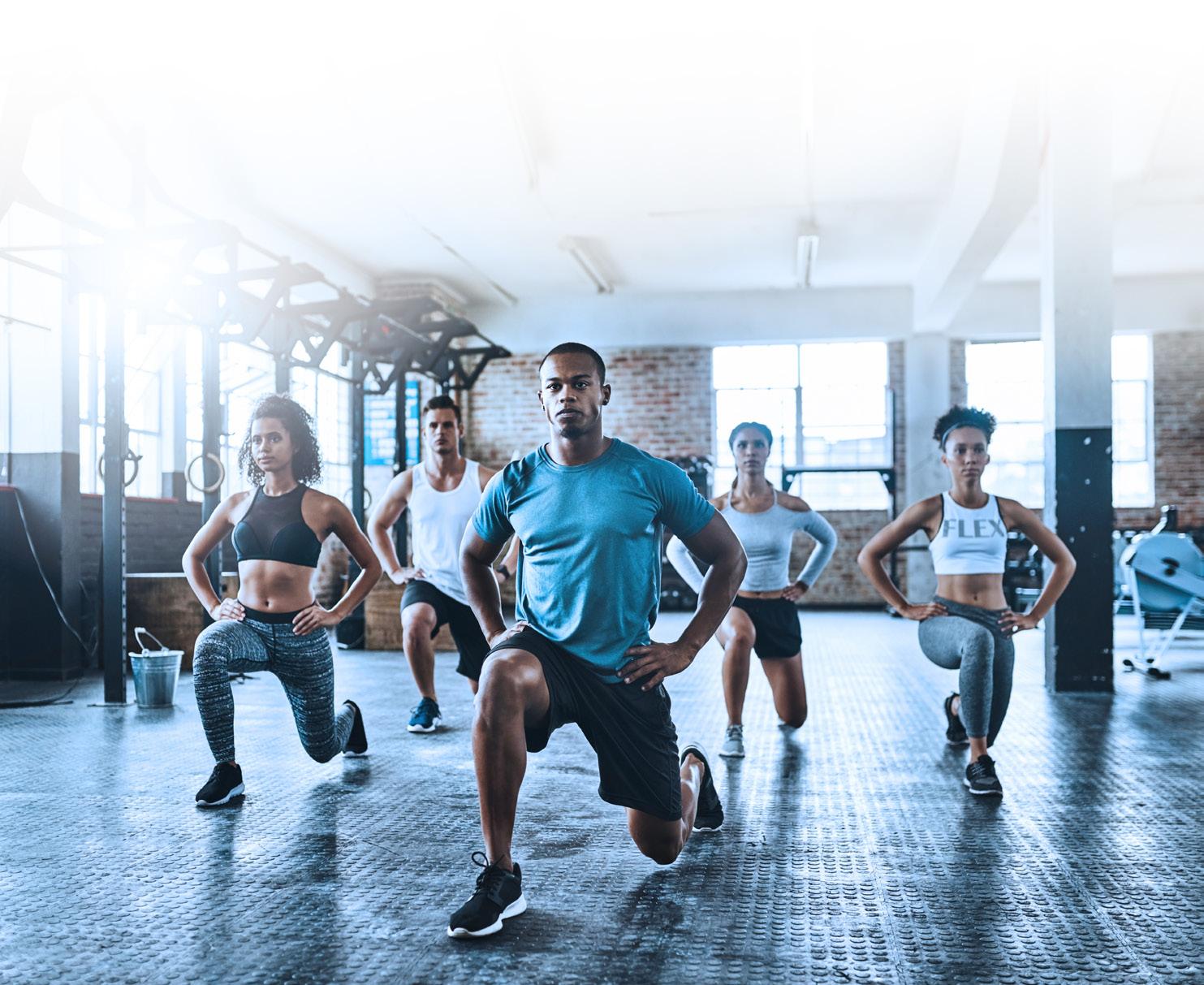

LEAD EVERYWHERE Become a FITNESS INSTRUCTOR SPECIALIST and lead group tness classes. can tpro.com/ tness-instructor-specialist

































































































 By Carol Harrison, RD
By Carol Harrison, RD






 By Lorne Opler
By Lorne Opler
















 By Sarah Zahab, BSc., R. Kin, CEP
By Sarah Zahab, BSc., R. Kin, CEP






 By Kathleen Trotter, MSc., FIS, PTS
By Kathleen Trotter, MSc., FIS, PTS

 Trotter, MSc.,
Trotter, MSc.,






